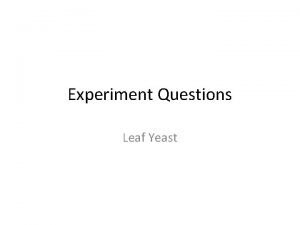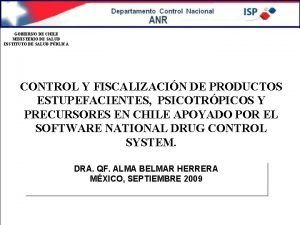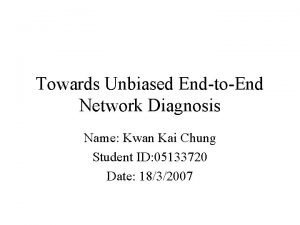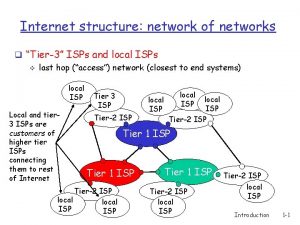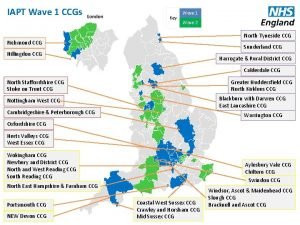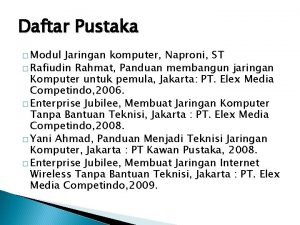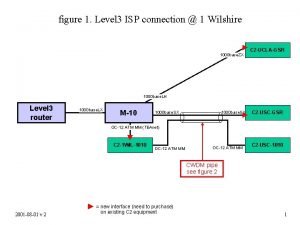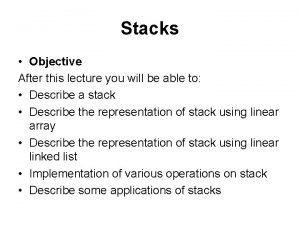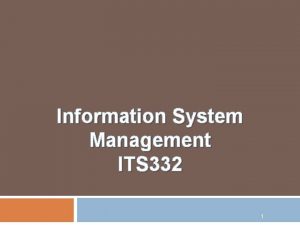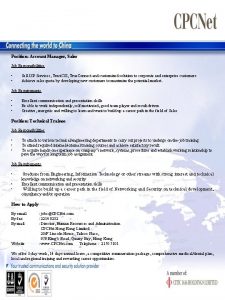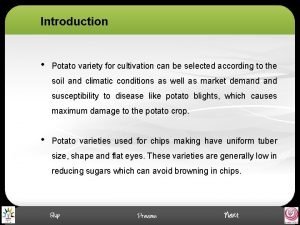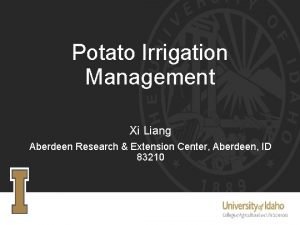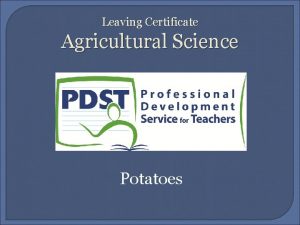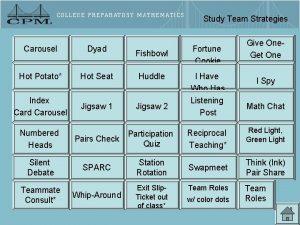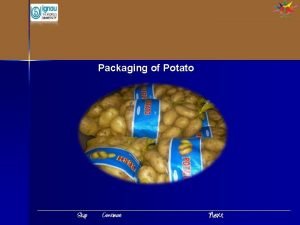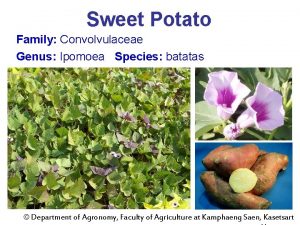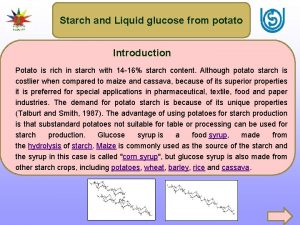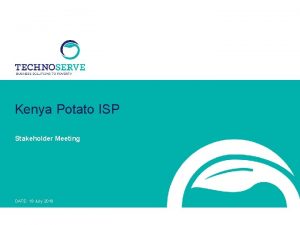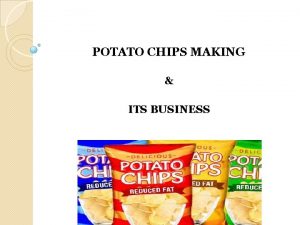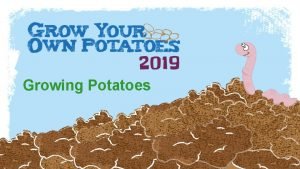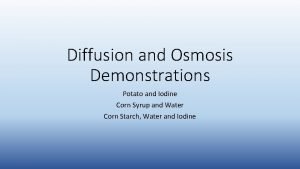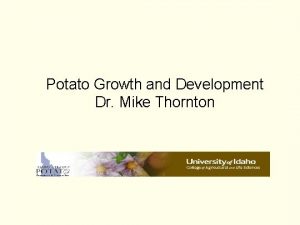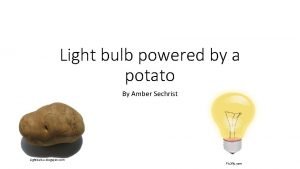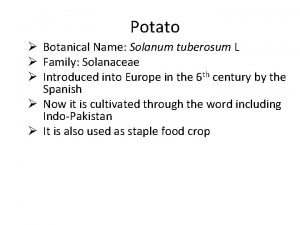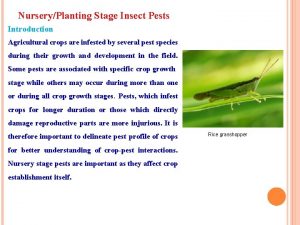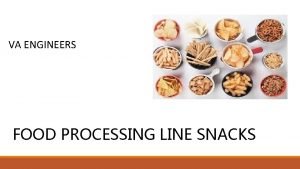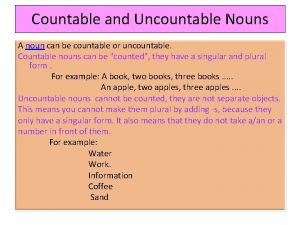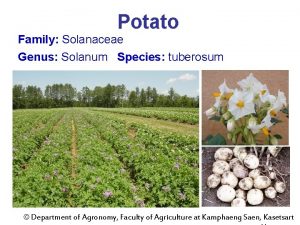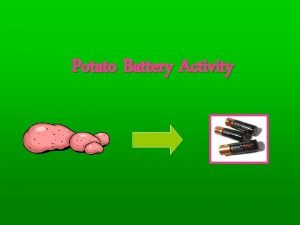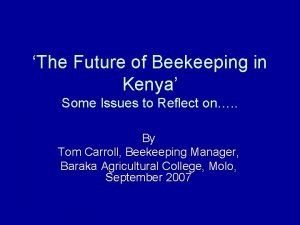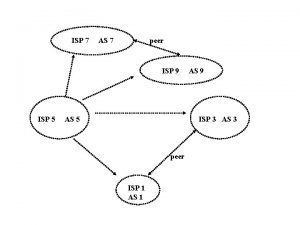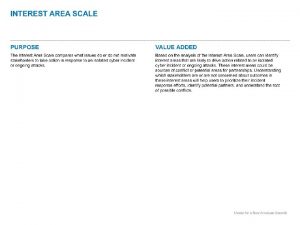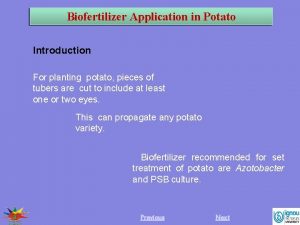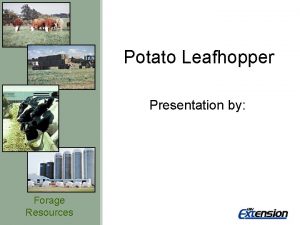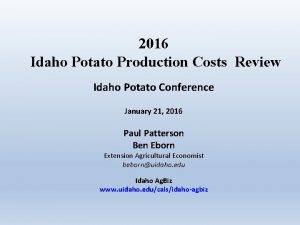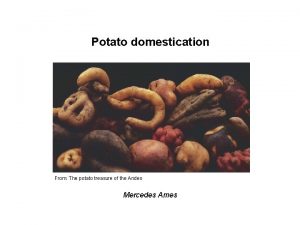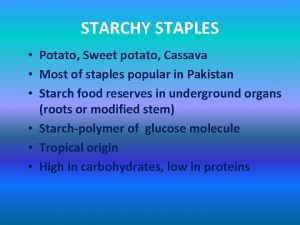Kenya Potato ISP Stakeholder Meeting DATE 19 July





















































































































































- Slides: 149

Kenya Potato ISP Stakeholder Meeting DATE: 19 July 2018

Agenda • Exec Summary • Potato Market Overview • Intervention Deep Dives and Business Cases • Recommendation and Roadmap Techno. Serve | 2

Executive Summary (1/2) • • Potato contributes 30 -40 B KSh p. a. at retail, but production has not grown since 2010 Globally, potato has proved a staple crop driving both food security and GDP growth. Countries like Egypt, South Africa & India use it both locally and for export In Kenya, potato can drive critical national outcomes: Food Security and Cost of Food: Kenya aiming for food security by 2022; targeting increasing potato volumes to 2. 5 Mt p. a. GDP: Doubling yields with ~40% of farmers would result in a 0. 3% increase in GDP Smallholder profitability: Per acre, farmers could increase profit by 70 -140 K KSh p. a. However, potato facing challenges across the value chain: Seed: Certified seed can increase yield from ~8 t/ha to 16 -20 t/ha for smallholders, but currently ~5% of the demand satisfied (2017) Production: Average yield of ~8 t/ha significantly lower than other African and global benchmarks (20 -40 t/ha), reducing smallholder profitability and industry competitiveness Aggregation: Structural inefficiencies increase retail cost of potato by ~20%, reducing farmer margins and retail demand. Buying patterns result in post-harvest loss of 20 -30% Processing: Ineffective contracts and lack of access to quality potato restricting formal processing into chips and crisps to 5% of total potato volume Retail: Seasonal price volatility with shortage prices 1. 5 -2 x higher than in glut period Business Solutions to Poverty Techno. Serve | 3

Executive Summary (2/2) • Highest priority interventions should focus on seed and farmer groups, while encouraging business opportunities in processing, irrigation and mechanization. Interventions can be considered in 3 phases Within the next year (quick wins): strengthen existing farmer groups and leverage dairy co -operatives, prove viability of C 3 multiplication, implement 50 kg bagging, reduce duplication of extension programs and improve packages for smallholders Within the next 3 years: scale out irrigation and mechanization, famer group seed multiplication and aggregation, public-private partnerships unlock land for large-scale seed and ware production, regional chips processing Beyond the next 3 years: grow retail consumption, large scale investment in processing, research in cuttings and true seed Business Solutions to Poverty Techno. Serve | 4

Potato industry facing challenges across the value chain Seed & Inputs • Quality seed biggest driver of yield, but only 1 -2% farmers use it • Only 5% of required quality seed being produced • Distribution & storage difficult because of potato bulk • Limited disease free land • Varieties not tailored to market demands • Some seed producers not aligned with KEPHIS on current regulations • High cost and time to certify seed Production Aggregation & Distribution • Avg yields of 8 t/ha • Lack of farmer groups lower than benchmarks and fragmentation of of 20 -40 t/ha brokers leads to inefficient distribution – • Limited irrigation low prices for farmers, prevents off-season high retail prices growing to reduce price volatility • Distribution expensive: potatoes bulky, poor • Farmers tend to sell road quality immediately (when prices low) storage • CESS fees charged by business case unclear bag not weight, driving waste & obscuring • No market for quality or pricing transparency variety. Shangi grown because it sprouts quickly and sells well (but spoils & increases post-harvest loss) • Soil testing or blended fertilizer rarely used and use of DAP increases soil acidity Business Solutions to Poverty Processing Retail • Processors complain • Seasonality in potato about inconsistent production leads to supply and quality price volatility high end retailers (e. g. • Inefficient distribution KFC) choose to import results in large • Contract farming not variation of prices working – smallholders across the country side sell, processors • Market prioritises fresh pay late or only buy potato, disincentivising large potatoes (leaving longer-lasting varieties farmers with 50% or storage leftovers) preference for Shangi • Ideal processing because of quick boil varieties not grown due time and trust to lack of market linkages • Chips processing inefficient, encouraging high degree of informal processing Techno. Serve | 5

Interventions to address these problems can focus on a number of different areas (1/2) Attractiveness Intervention Seed Multi & Storage Production Farmer Groups Value of Smallholder Food Security Opportunity Profitability Time to Achieve Critical enabler for seed, production & marketing initiatives Post-harvest Loss Low Gov’t / Regulator Gov’t extension support and access to markets needed Local production, Existing attempts Limited capacity To improve Gov’t extension storage & have struggled with currently – needs to governance, provide support and access aggregation governance, scale be built services to markets needed increase profitability & seasonality When feasible 10% mechanize Ware Storage Investment Required Opportunity of 3 -5 B Improved efficiency Full transformation Requires access to Input packages Best practice can Ksh p. a. if 40% of by 40% of farmers dependent on seed, step change in should be simple drive 2 -3 x return for farmers increase could unlock ~0. 5 Mt scaling seed, extension efficacy & Need to find lower avg. smallholder yields by 75% of additional potato addressing disease farmer practices interest sources Opportunity of ~1 B Marketing & Aggregation Complexity Medium Opportunity of 1 -2 B Requires co. Clearer standards Increased yields can Scaling seed Expensive purchase KSh p. a. if 40% of Critical to increase ordination between communication drive 2 -3 x return for industry a 5 -10 year of land, equipment farmers use quality yields by 50 -100% investors, gov’t and Cost and time to avg. smallholder journey and storage seed regulators certification Need to identify Can increase Mechanization KSh p. a. for farmers reduces waste by 5 - regions with larger available stocks by 5 & ~1 B for MSPs if 10% and increases land sizes and fund (Production) -10% Irrigation High yields by ~30% new entrants Small land sizes; hilly land hard for mech to access Support to purchase tractors & specific potato mech Can be driven by private sector Opportunity of ~1 B Would unlock Best practice can Affordable irrigation Investment in land, Support needed Training & financing KSH p. a. for farmers additional land drive 2 -3 x return for available – needs irrigation and other unlocking land critical to roll out if 10% irrigate all-year production avg. smallholder pilots as proof equipment (potential for PPPs) Doesn’t create value Reduces prices & – moves from waste, incentivises brokers to farmers more growth Price key driver of profitability Farmer group & gov’t intervention likely required Broker networks, informal market, price pressure Limited financing needed Enforcement of bag regulations & align CESS approach Most models don’t Can smooth price Limited profitability have return on volatility, even with for smallholder investment local ambient stores without subsidy Financing for and construction of facilities Need to resolve business models and address profit Almost no models have path to profitability Can be driven by private sector, but gov’t can invest 50 kg bags help Mech & training slower Co-ordinate across industry (mech, training & gov’t) Driven by mech & aggregation changes Would be helped by aggregation changes 10 -15% uplift possible with best practice Business Solutions to Poverty Current losses of Only ~60% of loss ~20% - but can’t all comes at farm level be removed Techno. Serve | 6

Interventions to address these problems can focus on a number of different areas (2/2) Attractiveness Intervention Value of Smallholder Food Security Opportunity Profitability Opportunity of ~0. 5 B Processing KSh p. a. if informal chips market (Chips, Crisps) Limited impact on food security captured Provide financing & extra 3 -4 KSH/kg Processors prefer large farmers Other Process Limited demand in Reduces availability Provide financing & Kenya / Africa. Cost extra 3 -4 KSH/kg of potato for (Frozen, / quality concerns Processors prefer consumption Dehydrated) prevent export large farmers Time to Achieve Awareness campaign to grow market, set up additional capacity Requires full industry transformation / creation High Complexity Medium Investment Required Gov’t / Regulator Need to break into Required to support regional centres & expansion or new identify model for entrants smaller retailers Crisps higher cost Industry doesn’t exist – needs infra, capacity (process & production) Low Can be driven by private sector Establishing new industries with no historical basis Gov’t support likely required to establish new industries Retail Consumption Growing market by Greater demand Growing market for Difficulty of changing 10% increases value as a potato increases cultural preferences by ~2 B KSh food security crop prices Funding for awareness campaigns Gov’t campaign & promote at schools, hospitals Industry Coordination Clarity to industry Drives profitability of Alignment of Tend to focus more Organisations exist, adds value across market & adoption of stakeholders & clear on broader industry need to be improved value chain best practice vision & financing All stakeholders should contribute Gov’t can support with clearer points of contact for potato N/A Regulation Acts as go/no-go for Seed decisions have Changes require some seed impact on higher impact on lobbying & proof of production models yields smallholders impact Needs improved communication Gov’t Intervention Facilitate investment, land, control legislation Unlocks land, supports efficient market Provide extension services, support market Changes require Many stakeholders resources, lobbying (county, national), – gov’t process complex processes N/A Financing Critical to unlock investment across value chain Minimise Need to see & track Historically difficult dependence where progress to free problem, complex possible funds market N/A Consistent approach to policy & regulation needed Development / Corporate Programs Strong impact on those smallholders targeted Can support best practice growing & market linkages Define many of the packages adopted by smallholders N/A Should be resolved through industry coordination Business Solutions to Poverty Requires clarity around what best programs are Alignment of various stakeholders has been challenging Techno. Serve | 7

Agenda • Exec Summary • Potato Market Overview • Intervention Deep Dives and Business Cases • Recommendation and Roadmap Techno. Serve | 8

Potato is the second most important Kenyan food crop Kenya’s Crop Production – Potato 2 nd most important Kenya’s Crop Production 2018 (Million MT) History of Potato in Kenya • Potato introduced to Kenya in late 19 th century, and has seen strong growth since the 1970 s • Now a major cash crop in 15 counties, and becoming increasingly popular in Rift Valley and Western Kenya • Research and release of varieties traditionally done by KALRO and CIP, but with new international varieties also being introduced now • Potato now the second most important food crop after maize – ~800, 000 farmers currently growing potato, ~90% on less than an acre 4. 5 4 3. 5 3 2. 5 2 1. 5 1 0. 5 0 Maize Source: “The Big Four” Agenda Paper (2017) Potato Rice Techno. Serve | 9

Potato is grown as a major crop in 15 out of 47 counties by ~800 K farmers Elgeyo-Marakwet • ~130 K farmers, annual production ~290 k. T Bungoma • ~6 K farmers, annual production ~120 k. T Nakuru • ~20 K farmers, annual production ~160 k. T • 3 seed producers: ADC, Agri. Co, Charvi Nyandarua • 170 K farmers, annual production ~270 k. T • 1 seed producer: Suera Meru • ~110 K farmers, annual production ~160 k. T • 1 seed producer: Kisima Kiambu • ~120 K farmers, annual production ~60 k. T Major potato growing counties Source: TNS Analysis, Value Chain for Seed & Ware Potatoes (2013), Modernization Options for the Potato Value Chain (2016), county reports (2016) Techno. Serve | 10

After steady growth, productivity has stalled Production (t) and Yield (t/ha) (2000 -2023 F) 1, 600, 000 12. 0 Since 2010, yields have fallen into a 6 -9 t/ha range 1, 400, 000 10. 0 1, 200, 000 8. 0 1, 000 800, 000 6. 0 600, 000 400, 000 200, 000 Production steady since 2010, but driven by more land for potato production Yields and production grew steadily until 2010 4. 0 2. 0 - 2000 2005 2010 2011 2012 2013 Production (t) 2014 2015 2016 2017 2018 F 2023 F Yield (t/ha) Without intervention, forecasts suggest little change by 2023 Note: FAO data has been adjusted due to inexplicable jumps in yields (from 8 to 20 t/ha and back some years) Source: TNS Analysis, FAOSTATT, Expert Interviews Techno. Serve | 11

As a result, Kenya struggles to compete with regional potato producers – particularly Egypt and South Africa Kenya’s yields comparatively low Yields Per Country (t/ha) Insights • Kenya yields lower than regional comparatives – particularly biggest producers in Egypt and South Africa • Main points of differentiation are: 40 35 30 25 • • Lack of quality seed available • Unclear market (largely informal, missing infrastructure) and price volatility reduce smallholder incentive to invest and achieve profits 20 15 10 5 ric a yp t So ut h Af Eg a nd ga U Ta nz an da R w an a ny Ke ia 0 Farm size – most farmers smallholders growing potato on <0. 5 acres per season. This often prevents investment in technologies such as irrigation and mechanization Source: TNS Analysis, Investment Opportunities for Potato in East Africa (2016), FAOSTATT Techno. Serve | 12

Quality seed is the greatest driver of productivity, but not widely available Quality Seed Supply / Demand (k. T) 350 300 250 200 303 150 100 50 0 91 5. 6 2016 10. 6 12. 6 2018 F 2023 Plan Seed Supply Note: 2018 demand based on assumption that producers replace seed every 3 -4 seasons Source: TNS Analysis, Seed Producer Interviews 2018 Demand 2018 All Seed Demand Techno. Serve | 13

Moreover, farmers and market prefer Shangi – which is less available than other varieties Shangi most popular with market, but not being grown for seed as much Certified Seed Varieties (k. T) Kenyan Seed Choices • 100% Smallholders and market prefer Shangi since it was introduced in ~2012: 90% • Short dormancy reduces need for storage and lets some farmers to get 3 seasons p. a. 80% • Established market position means brokers only buy or pay more for Shangi • For consumers, Shangi is sweeter, and boils faster than most other varieties (~5 minutes) 70% Other Table 60% Other Processing Jelly 50% • Cherokea 40% However, Shangi comes with challenges: • Short dormancy prevents storage, reducing value for food security & increasing waste • Not a good variety for processing, hampering growth of chips and crisps industries • Dominance of 1 variety heightens disease risk & reduces options for smallholders Dutch Robyn 30% Shangi 20% 10% 0% Certified Seed • Seed multipliers have stayed away from Shangi for these reasons (esp. high waste) • As a result, Shangi yields are low from reuse, while new varieties aren’t adopted Ware Source: TNS Analysis, Seed Producer Interviews, Expert Interviews, Post-harvest losses in potato value chains in Kenya (2014) Techno. Serve | 14

Introduction of Potato Cyst Nematode (PCN) has further lowered yields, particularly in areas without crop rotation • • • Potato cyst nematode introduced to Kenya some time in the last decade PCN intensified by using same land for potato each season, and spread through soil on potatoes in informal seed system Testing of soil samples shows it has now spread throughout Kenya’s potato growing counties • • • Now particularly prevalent in counties with high seed re-use, small land sizes and multiple seasons per year – particularly central Kenya Causes up to 80% reduction in yields. Potentially the main cause of falling yields (particularly in central Kenya) PCN difficult to manage: Can stay dormant in soil for up to 20 years Spreads rapidly once in soil and potatoes grown on it Spray treatments very expensive Crop rotation most effective long-term management (best practice in Europe), but complex in Kenya due to small land sizes and lack of testing Newer technologies to manage (trap crops, banana paper) in testing, but not yet fully developed or rolled out (covered later in presentation) Techno. Serve | 15

Marketing difficulties in a largely informal market reduce smallholder profitability and willingness to invest… In informal market, brokers take majority of the profit available Brokers tend to maintain these margins regardless of retail price – squeezing smallholders Most consumption done informally where brokers control prices Retail Potato Consumption (~0. 78 Mt, 2018) 2% 2% 4% 13% 79% Table Informal Chips Formal Crisps Supermarket Source: TNS Analysis, Broker & Wholesaler Interviews, Post-harvest losses in potato value chains in Kenya (2014) Formal Chips Techno. Serve | 16

… particularly since seasonal volatility leads many to sell during lower price periods Prices can increase by ~50%, and often vary significantly across counties Wholesale White Potato Prices 2016 -2018 (KSh/kg) 120 100 Nakuru market tends to have highest spikes & dips 80 60 40 Source: TNS Analysis, NAFIS Wholesale Prices (2016 -2018) Mombasa /1 8 /0 5 /1 8 /0 4 28 28 /1 8 /0 3 28 /0 2 /1 8 28 /0 1 28 /1 7 /1 2 /1 7 /1 1 28 /1 0 /1 7 28 /0 9 /1 7 /0 8 28 Nakuru 28 /1 7 /0 7 /1 7 28 /0 6 28 /1 7 /0 5 28 /0 4 /1 7 /0 3 28 /1 7 Nairobi 28 /1 7 Other markets tend to fluctuate with 50 -100% difference between peak & low /0 2 28 /0 1 /1 6 30 /1 6 /1 2 30 /1 1 30 /1 6 /1 0 30 /0 9 30 /1 6 /0 8 /1 6 /0 7 30 /1 6 30 /0 6 30 31 /0 5 /1 6 0 /1 6 Eldoret potato significantly cheaper in 2016 & early 2017, but no longer 28 20 Eldoret Techno. Serve | 17

However, as seen throughout Africa, potato can be a critical agricultural product Egypt South Africa • Egypt one of world’s largest potato exporters – exporting frozen chips, as well as table potato to Europe, Middle East and Africa • Tripled value of potato industry over last 15 years, driven by greater focus on seed and processing • Have successful import oriented seed system – allows local producers to tailor production to export market requirements • Encouraged adoption among large scale farms with irrigation and mechanization • Strong central regulatory and trade organisations enforcing quality standards – particularly when it comes to market access Rwanda • • • Malawi Potato identified as one of six priority crops • Attracted $120 M in foreign investment for processing and seed multiplication – with aim of producing frozen chips for export Production and consumption of potato has become critical to increasing food security - >100 kg person, per year • Introduced irrigation to provide additional annual crop Government has made additional land available to ensure clean land for production Techno. Serve | 18

Agenda • Exec Summary • Potato Market Overview • Intervention Deep Dives and Business Cases • Recommendation and Roadmap Techno. Serve | 19

15 Potential Intervention Areas Assessed 1 • Seed Multiplication and Storage • 9 Processing (Chips, Crisps) 2 • Production 10 • Other Processed (Frozen, Starch) 3 • Farmer Groups 11 • Retail Consumption 4 • Mechanization (Production) 12 • Industry Co-ordination 5 • Irrigation 13 • Regulation 6 • Marketing and Aggregation 14 • Government Intervention 7 • Ware Storage 15 • Financing • Post-harvest Loss 16 • Development / Corporate 8 Programs Techno. Serve | 20

1 Seed: Overview Quality seed meets <4% of minimum demand Quality Seed Supply and Demand (k. T) Kenyan Seed Industry Overview • 150 Most seed recycled by farmers, with Shangi dominant. Limited adoption of other varieties • 100 50 • 0 2005 2010 2015 2016 2017 2018 F 2023 FBased on planned Supply Demand (Min) production 3 main business models for growing seed • From breeder seed: license local or international varieties, grow them from minitubers through to C 2 (e. g. Kisima, ADC) • Buy basic seed: followed by 1 -2 multiplications (e. g. Agri. Co, Charvi, Suera) • Clean seed multiplication: buy from certified producer, before multiplying on local scale 5 main farms supply ~80% of seed Certified Seed Stakeholders (k. T) 15 Expected 2000 t in seed expected to be added by Kirinyaga Seeds in 2021 10 5 • Recent investment with Charvi, Agri. Co, Suera, Kirinyaga ramping up, and others considering (Bubayi, Agri. Ventures) • “Clean Seed” has come in & out of popularity – currently not promoted (or fully legal) • KEPHIS responsible for regulation and certification 0 2019 F Kisima Agri. Co ADC Charvi Suera Other Source: TNS Analysis, Seed Producer Interviews, FAOSTATT, KEPHIS Interviews Most certified seed being produced is for varieties without a clear market Techno. Serve | 21

1 Seed: Overview Suera Flowers (Nyandarua) • • • Seed imported in partnership with Meijer Focus on processing varieties Current annual seed production ~700 t on ~40 hectares (from 2019) Agri. Co (Nakuru) • • • Seed imported (Agri. Co) Focus on processing varieties, but expanding into table Current annual seed production ~1800 t on ~50 hectares ADC Molo (Nakuru) • • • Grown from breeder seed Mostly local varieties suitable for table and processing Current annual seed production ~1100 t on ~70 hectares Kisima (Meru) • • • Grown from breeder seed. Partner with HZPC Mix of local and imported varieties suitable for table and processing Current annual seed production ~1700 t on ~100 hectares Charvi (Nakuru) • • • Seed imported in partnership with Europlant Focus on processing varieties Current annual seed production ~1100 t on ~40 hectares Major potato growing counties Source: TNS Analysis, Seed Producer Interviews Kirinyaga Seeeds (Kirinyaga) • • • Grown from breeder seed. Partner with IPM for varieties Mix of local and imported varieties suitable for table and processing Expected production in 2021 of ~2000 t on 100 hectares Techno. Serve | 22

1 Seed: opportunities and challenges Opportunities • Only ~5% of low case demand for certified or clean seed currently satisfied • Discussions with farmers and collectives show desire for quality seed, but a lack of awareness of how to get it • • • Collectives interested in seed multiplication Models combining seed production with extension services and market linkages increase seed demand improve smallholder yields Government (county and national) increasingly interested in addressing seed shortage and removing bottlenecks Challenges • Farmers and market prefer Shangi, which is a difficult variety to grow and store for seed because of short dormancy • Limited amount of disease free land available for seed multiplication • Large scale certified seed requires large farms and investment. For genetic material model – can take >2 years to generate revenue. Financing may be complicated • • Potato bulky: distribution & storage difficult Challenges with regulatory environment: • KEPHIS inspection costs high and capacity to rapidly inspect low (not enough resources) • Processors demand better quality, which provides market for early investors in seed • Seed producers unclear on standards around imports, disease • Investment required for clean seed multiplication relatively low • C 2 limit for multiplication (based on disease threshold) increases unit cost of seed Techno. Serve | 23

1 Seed: Key Success Factors Scale of Farm Best Practice Agronomy Right Varieties Description • • • Economics of seed, particularly for certified, driven by scale >20 hectares per season • • • Invest in agronomic advice to continuously improve yields • • • Varieties should be chosen based on a clear market demand – whether processor or ware • Cold storage critical to avoid waste, allowing you to store seed if you have too much for this round of multiplication (for up to 10 months) • Storage relieves pressure on quick sales, allowing you to better co-ordinate with farmers Storage Mechanization & storage significantly cheaper at scale. Also applies to certification For clean seed (or late stage multiplication), smaller sizes more feasible if local demand Practice crop rotation (3 -4 year rotation) to avoid disease (biggest business risk) Seed is a high value crop (relative to ware), so investment in better quality inputs and soil analysis is more important Therefore, investigation into consumer needs critical before scaling up varieties Growing multiple varieties and introducing new varieties slowly can help to hedge risk Techno. Serve | 24

1 Seed: Certified Seed Investment Thesis (from in-vitro) Consider Investment: particularly for large commercial farmers due to under-served market and potential for high margins. High investment cost, access to land time to value biggest risks. Also provides good rotation crop and boosts sustainability Requirements: Major Risks: • Financing: likely >100 M KSh for certified seed. Some possibility of PPPs for storage and land • Need to multiply for 4 seasons before having a saleable crop cash flow delayed • Discussions with KALRO / CIP / KEPHIS / int’l breeders regarding best placed varieties and arrangements on certification and licensing • Large investment required in storage and mechanization – financing costs and risks • • Access to land: test for suitability of climate & soil. Choose site without competitors. Minimum land of 200 hectares (assuming 4 year rotation) needed Introduction of new diseases or contaminated land, as well as climate change, can impact yields or result in crop’s destruction • Choosing varieties without clear demand can result in write-offs • Outreach to local smallholders and processors to ensure market demand provide support • If you can stagger planting and harvesting, you can reduce investment in machinery and storage Techno. Serve | 25

1 Seed: Certified Seed Business Case (from in-vitro) Annual Profitability Based on Farm Size and Yield (KSh) Land (ha) Yield (t/ha) 100 KSh = 1 USD Insights • Land size and yield the biggest drivers of profitability • Under normal conditions, seed multiplier be able to make a profit – but difficulty is achieving return on investment • To secure a positive return on investment within 6 years, investors should look at minimum 60 ha p. a. and aim to achieve a yield of at least 27 t/ha (incl. waste and ware) • Benchmarks suggest such a yield is achievable Achieve 45 M KSh profit p. a. and payback investment within • 6 years Source: TNS Analysis, Seed Producer Interviews & Financial Reports Lower financing cost or existing land or equipment allow sustainability on smaller land sizes or lower yields Techno. Serve | 26

1 Seed: Certified Seed Business Case (from in-vitro) Key Assumptions • • • Seed grown from genetic material • • • ~80% of output sold as seed, 15% waste (in field or storage), rest is ware • • • Seed sold at 55 KSh/kg. Ware sold at 13 KSH/kg (avg. of market) Royalties of 2. 5% of revenue based on KALRO. Using foreign varieties can attract royalties up to 10% (for exclusive varieties) 100% of seed and ware sold For a farm with 100 hectares under production p. a. , investment of ~150 M KSh includes: • 45 M KSH for 1000 t cold storage • 100 M KSh for tractors & equipment • 10 M KSh for packaging • 3 M KSh for aeroponics Assumed risk weighting of 10% cost of finance Aim to break even in 6 years of start. Takes 2 years to generate revenue Techno. Serve | 27

1 Seed: Certified Seed Investment Thesis (from basic) Consider Investment: particularly for large commercial farmers due to under-served market and potential for high margins. High investment cost and having imports seized due to disease the major risks. Also provides good rotation crop and boosts sustainability Requirements: Major Risks: • Financing: likely >100 M KSh for certified seed. Some possibility of PPPs for storage and land • • Discuss best varieties with KALRO / CIP / breeders Feasibility of compliance with KEPHIS regulations while achieving profitability. When importing, moderate risk of container seizure • Partner (can be exclusive or non-exclusive) with an int’l or local breeder to source basic seed • Large investment required in storage and mechanization – financing costs and risks • Discuss how to import / purchase with KEPHIS • • Access to land: test for suitability of climate & soil. Choose site without competitors. Minimum land of 200 hectares (assuming 4 year rotation) needed Introduction of new diseases or contaminated land, as well as climate change, can impact yields • Choosing varieties without clear demand can result in write-offs • Outreach to local smallholders and processors to ensure market demand provide support • 2 multiplications to reduce unit cost of production • If you can stagger planting and harvesting, you can reduce investment in machinery and storage Techno. Serve | 28

1 Seed: Certified Seed Business Case (from basic) Annual Profitability Based on Farm Size and Yield (KSh) Land (ha) Yield (t/ha) 100 KSh = 1 USD Insights • Land size and yield the biggest drivers of profitability • Under normal conditions, seed multiplier be able to make a profit – but difficulty is achieving return on investment • To secure a positive return on investment within 6 years, investors should look at minimum 60 ha p. a. and aim to achieve a yield of at least 30 t/ha (incl. waste and ware) • Benchmarks suggest such a yield is achievable Achieve 40 M KSh profit p. a. and payback investment within • 6 years Source: TNS Analysis, Seed Producer Interviews & Financial Reports Lower financing cost or existing land or equipment allow sustainability on smaller land sizes or lower yields Techno. Serve | 29

1 Seed: Certified Seed Business Case (from basic) Key Assumptions • • • Seed imported or bought locally at basic stage • • • ~80% of output sold as seed, 15% waste (in field or storage), rest is ware • • • Seed sold at 55 KSh/kg. Ware sold at 13 KSH/kg (avg. of market) Royalties of 10% of revenue for imported seed with exclusive rights, 2. 5% for local seed (or free depending on variety) 100% of seed and ware sold For a farm with 100 hectares under production p. a. , investment of ~150 M KSh includes: • 45 M KSH for 1000 t cold storage • 100 M KSh for tractors & equipment • 10 M KSh for packaging Assumed risk weighting of 25% due to higher risk of importing / moving seed 10% cost of finance Aim to break even in 6 years of start. Takes 1 year to generate revenue Techno. Serve | 30

1 Seed: Local Clean / Certified Seed Multiplication Investment Thesis Consider Investment: for small / medium (2 -5 hectares) farmers to undertake late stage multiplication for seed due to underserved market and potential for high margins. If certifying need to manage KEPHIS costs and risk of disease. For clean seed, potential for KEPHIS crackdown Requirements: Major Risks: • Financing: ~250 K KSh / hectare upfront for inputs, testing and land for first season. ~800 K KSh for 50 t seed store (ideally DLS) • Cost of investment in storage • Certifying seed can result in destruction of crop if disease found • Buy C 1/C 2 seed from local producers and multiply 1 -2 times for sale as certified / clean seed. Try to ensure consistent supply • Clean seed is in a legal grey area due to lack of KEPHIS certification. Also dependent on other farms for starter (certified) seed • Identify local varieties w/ clear market: often Shangi • • If certifying, connect with KEPHIS Introduction of new diseases or contaminated land, as well as climate change, can impact yields • Access to land: test for suitability soil. Choose site without competitors. Minimum land of 2 ha for clean seed (per season) and 5 ha for certified. Account for crop rotation of 3 -4 years Techno. Serve | 31

1 Seed: Local Certified Seed Business Case Profitability per Season Based on Farm Yield (KSh) 800000 Insights • Yield the biggest profitability driver. Land size important, but limited benefits of scale after 2 ha (or 5 ha for certified seed) • Under normal conditions, seed multiplier should be able to make a 50 K KSh profit per season and pay-off loan within 6 years with a yield of at least 15 -20 t/ha (incl. waste) • Limited investment cost after ~250 K KSh financing for first season secured, and ~800 K KSh seed store paid off • Benchmarks suggest such a yield is achievable – some farmers achieving 30 -40 t/ha 700000 600000 500000 400000 300000 200000 100000 0 15 20 27 Yield (t/ha) Minimum profit per hectare for viability 30 35 100 KSh = 1 USD Source: TNS Analysis, Seed Producer Interviews & Financial Reports Techno. Serve | 32

1 Seed: Local Certified Seed Business Case Key Assumptions • • Farmer multiplies certified seed and sells as clean • • Minimum suggested size of farm ~2 hectare, but limited scale advantages Seed sold at 45 KSh/kg. Farmers don’t re-use seed but buy new each season Seed purchased at 55 KSh/kg Seasonal KEPHIS certification (~13 K KSh / ha) 15% waste (in field or storage) 100% of seed sold Investment only required for storage (~800 K KSh for 50 t) – land rented and mechanized service provider used Assumed risk weighting of 10% 15% cost of finance, 7% for insurance Minimum profit per hectare: 50000 KSh Techno. Serve | 33

1 Seed: New Technologies - Cuttings Overview • • • Apical Cuttings an alternative to mini-tubers Produced in greenhouses from tissue culture – then planted to generate tubers. From there, normal seed production continues Advantages: All Costs in KSh Cuttings Mini-tubers # units 1, 100 1, 111 Planting Material Cost 16, 500 22, 222 • 20 -100% higher yields than from mini-tubers Production Cost 6, 000 4, 000 • Reduced disease risk as mini-tuber stage of planting in soil is skipped Total Cost 22, 500 26, 222 Yield / Unit 8 6 Cost / Unit 2. 81 3. 93 • • Business Case Can multiply extra time & still certify (TBC) Disadvantages: • Need to be planted & watered immediately (24 hours) – then requires regular water. Some form of irrigation recommended • Currently in testing between CIP & Stokman Rozen for a range of varieties • KEPHIS approved for use as certified seed Source: TNS Analysis, Expert Interviews, CIP Cuttings Trials Successfully applied, using cuttings can reduce cost / ha of sellable seed by ~30 K KSh Techno. Serve | 34

1 Seed: New Technologies - Cuttings Techno. Serve | 35

1 Seed: Case Study - Kisima Overview • Started investment in 2012, partnering with HZPC for imports, and using local varieties • 80% for table, and 80% local • 30% Cherokea, 15% Asante, 15% Dutch Robin, 9% Unica, 8% Panamera • • Seed grown from genetic material • • Sales at farm gate – no distribution required Now growing on 100 hectares a year, producing 1500 -2000 t of seed Key Lessons: • Invest in cold storage to reduce waste • Use a mix of varieties, including popular local table varieties to ease marketing introduce new varieties slowly to manage risk and test market and consumer acceptance • Target and support local smallholders to guarantee market and improve yields • Patience on returns important particularly when working from genetic material Techno. Serve | 36

1 Seed: Enabling Environment Recommendations Gov’t & Regulatory Interventions • • Other Enabling Environment Interventions • Create greater market transparency on where demand for seed is, and where it can be found • Clearer communication between seed producers and KEHPIS and investigate permanent extension of C 3 multiplication limit Continue training smallholders on profit opportunities from using quality seed ensure certified seed part of packages • Support with construction of seed storage – particularly for farmer groups interested in last-stage clean / certified seed Support farmer groups to undertake their own multiplication: financing / insurance packages; training on agronomic practices • Make public lands available (investigate PPPs) where clean private land not accessible Identify and connect certified seed producers to grants and sources of cheap financing (where possible) • Support marketing of new varieties where practical benefit vs. Shangi • Continued research into new varieties, particularly focussed on table Accelerate path to privatised certification to reduce bottleneck through KEPHIS. Reduce cost burden to incentivise certified over clean seed multiplication Techno. Serve | 37

2 Production: Overview Volumes steady despite more land under production due to falling yields Production (t) and Yield (t/ha) (2000 -2023 F) 2, 000 12. 0 10. 0 8. 0 6. 0 4. 0 2. 0 - 1, 500, 000 1, 000 500, 000 20 05 20 10 20 11 20 12 20 13 20 14 20 15 20 16 20 1 20 7 18 20 F 23 F - Production (t) Composition of Potato Growers (2010) ~800 K • Potato used as a cash crop, with small amount saved for home consumption • Most smallholders grow potato as part of a broader mix, including dairy, other horticultural products (like cabbage) or maize • Land under production slowly expanding – particularly in Rift Valley and Western, though lower yields in central have hampered growth there • Yields have been falling over time, due to land fragmentation which prevents crop rotation and efficiencies of scale, as well as increasing build-up of diseases like PCN • Traditionally recycle seed or buy from neighbours • Most smallholders still work independently and depend on brokers to pack and take potatoes to market Yield (t/ha) Most farmers working on <1 acre land 100% Kenyan Smallholder Overview ~130 K ha 80% ~10 hectares+ 60% ~2 hectares 40% ~1 acre 20% ~0. 5 acre 0% # Farmers Land Note: FAO data has been adjusted due to inexplicable jumps in yields (from 8 to 20 t/ha and back some years) Source: TNS Analysis, FAOSTATT, Expert Interviews, Value Chain for Seed & Ware Potatoes (2013) Techno. Serve | 38

2 Production: Overview Elgeyo-Marakwet • ~130 K farmers, annual production ~290 k. T Bungoma • ~6 K farmers, annual production ~120 k. T Nakuru • ~20 K farmers, annual production ~160 k. T • 3 seed producers: ADC, Agri. Co, Charvi Nyandarua • 170 K farmers, annual production ~270 k. T • 1 seed producer: Suera Meru • ~110 K farmers, annual production ~160 k. T • 1 seed producer: Kisima Kiambu • ~120 K farmers, annual production ~60 k. T Major potato growing counties Source: TNS Analysis, Value Chain for Seed & Ware Potatoes (2013), Modernization Options for the Potato Value Chain (2016), county reports (2016) Techno. Serve | 39

2 Production: opportunities and challenges Opportunities • • Kenyan smallholders currently 70% below Africa best practice – significant opportunity for improvement, which would also significantly increase their profit Growing volumes of certified / clean seed available (investment from seed multipliers) which is the key driver of increased yields • Numerous extension / training programs to improve agronomy practices (GIZ, 2 Scale, Bayer, UPL, Mavuno Zaidi…) • Government considering re-allocating subsidies from maize focussed fertilizers to general input provision • Farm improvement technologies (mechanization, soil analysis) becoming more affordable and available Challenges • Small land sizes (90% on <1 acre for potato) makes investment riskier and rules out certain technologies (mechanization) • Poor agronomy practices result in lower yields and higher post-harvest loss • Build up of PCN due to re-use of seed and lack of rotation reduces yields • Use of subsidized DAP has increased soil acidity and reduces yields • Dependence on rain-fed farming results in over-supply that deflates prices • Farmers and market prefer Shangi, which is difficult to store because of short dormancy, and has higher susceptibility to disease • Lack of clear market beyond broker model results in lower prices • Lack of strong farmer groups reduces negotiating power

2 Production: Key Success Factors Description • Look to buy quality seed (ideally certified, but trusted clean seed also an improvement) to achieve higher yields • This seed can be re-used for ~3 seasons before yields fall and disease risk increases Best Practice Agronomy • • • Follow best practices on land preparation, planting, spraying/weeding & harvesting Fertilizer and sprays tailored to variety and land can significantly improve yields Quality Inputs • • • Don’t scale immediately to full land size, as this heightens risk as investment goes up • Understand the target market, and which varieties it requires. If looking at processing, ensure agreement or buyer (and price) established up front • Look for options to sell at times of shortage (investigate irrigation, storage) but should match capabilities of chosen variety (e. g. Shangi does not store well) • If possible, aggregate as farmer groups to increase market leverage Quality Seed Start Small Market Understanding Rotate crops on a 3 year cycle (or close as possible) to reduce impact of disease Where possible, leverage extension services for training and best practices Use soil analysis to decide on fertilizer to buy However – this investment is ONLY worthwhile if quality seed being used Instead, look to trial quality seed / inputs on 1/3 – ½ the land to prove the uplift If yields don’t increase (for instance disease risk from PCN) consider options (adjust variety, apply treatments or consider other crops) Techno. Serve | 41

2 Production: Investing in certified seed and quality inputs Investment Thesis Consider Investment: allows smallholders to achieve far higher yields – even on smaller plots of land – but profitability highly dependent on price achieved at market. Any investment should be staged, with a clear eye on the likely sale price for produce Requirements: Major Risks: • Financing: ~15 K KSh / acre upfront for certified seed (extra ~15 K KSh if soil testing and improved fertiliser desired) • Higher investment increases smallholder risk in case of any adverse climactic or production issues (consider insurance, but doesn’t cover everything) • Buy quality seed for 1/3 land as an initial test plot, and to multiply seed for future seasons. This also manages risk of investment • Low market price (7 -10 KSh / kg) can lead to losses even with higher yields. These losses can also be higher due to higher initial investment • Choose variety(ies) with clear market (either contract farming for processor, or local table variety) • • Work with local farmer group to reduce costs of transport, access to seed and open up post-harvest options (storage, market) (see farmer group section) In some areas, years of intensive potato farming have increased PCN density which limits uplift even with quality seed • Lack of clear market can prevent sale of increased production (or result in lower prices) • Soil testing and appropriate fertilizer can potentially be skipped initially, but over time will improve yields • Only scale up once model proven Techno. Serve | 42

2 Production: Quality Seed vs Re-used Seed Business Case Cost of Production (KSh/kg)* Yield (t/ha) 3 5 8 10 12 15 18 20 24 30 35 40 Re-Used Seed Certified Seed 25. 2 15. 1 8. 9 7. 6 6. 3 5. 0 4. 2 3. 8 3. 2 2. 5 2. 2 1. 9 40. 7 24. 4 14. 3 12. 2 10. 2 8. 1 6. 8 6. 1 5. 2 4. 1 3. 5 3. 1 Expected Yield Range Profit at 12 KSh/kg sale price (KSh/hectare)* Profitableeven Profitable at at 10 KSh/ kg market price Yield (t/ha) 3 5 8 10 12 15 18 20 24 30 35 40 Re-Used Seed Certified Seed (51, 499) (31, 579) 3, 442 18, 221 38, 141 68, 021 98, 567 117, 821 153, 179 217, 421 267, 221 317, 021 (101, 468) (81, 548) (46, 526) (31, 748) (11, 828) 18, 052 48, 599 67, 852 103, 210 167, 452 217, 252 267, 052 Profit at avg yield – hard to sustain under current model Profit at avg yield – covers initial seed investment 100 KSh = 1 USD Insights • Yield and market price the biggest drivers of profitability. At current avg yields farmers re-using seed need price of 15 -16 KSh/kg to cover family labour and make small profit. Farmers using certified seed need only 11 -12 KSh/kg • In general, certified seed farmers need to get 5 -8 t/ha more to justify investment * Does not include ~10 K KSh estimate for family labour Source: TNS Analysis, Smallholder & Expert Interviews, Seed Producer Interviews, KALRO Cost Analysis Techno. Serve | 43

2 Production: Quality Seed vs Re-used Seed Business Case Key Assumptions • • • Assumed smallholder, so no advantage for scale (since all relatively small size) Assumed cost of labour 250 KSh / day. Mixture of family and hired labour used For quality seed: • Seed purchased at 55 KSh/kg, and refreshed every 3 seasons. ~ 80 K KSh required for first season • Specialized fertilizer purchased (~31 K KSh/ha) • Regular spray regime (~19 K KSh/ha) For re-used seed: • Most seed re-used from previous season, and some supplementary farmer-saved seed bought if not enough • Subsidized DAP fertilizer purchased (~15 K KSh/ha) • Semi-regular spray regime (~9 K KSh/ha) 15% waste (in field or storage) Assumed risk weighting of 10% 15% cost of finance, 7% for insurance Seed sold at 15 KSh/kg Minimum profit per hectare: 30000 KSh Techno. Serve | 44

2 Production: New Technologies – Managing PCN with trap crops and banana paper Risk of PCN • PCN present in >50% of samples in 20 potato growing counties – many with rates about 80% • Over time, PCN concentration can result in 80% yield reduction – may explain difference between current yields in counties. For instance: • • • Trap Crops – African Nightshade (Mnavu) • Solanum scabrum can be used as a rotation crop that trigger PCN hatching without completion of lifecycle, reducing PCN density by ~80% and increasing potato yields by 2 -3 x • Berries of African nightshade can be eaten, and thus serves as supplementary food crop • Cost of planting and yield of nightshade to be investigated Nyandarua grows up to 3 seasons a year, with a long history of potato and seed sharing – yields falling to 6 -8 t/ha Elgeyo-Marakwet has been more isolated, with a lot of virgin land – yields still at 1315 t/ha Best practice management involves crop rotation, but hard in counties with small land sizes (<1 acre) Banana Paper • Currently being investigated as a wrapping for potato seed that both insulates the seed from PCN, and triggers hatching to reduce density over time • Initial trials have increased yields from ~7 t/ha to 25 -30 t/ha • Challenge currently cost of production and distribution Techno. Serve | 45

2 Production: Enabling Environment Recommendations Gov’t & Regulatory Interventions • Support local production of seed (or transport from other counties) to increase access • Alter existing subsidy schemes (fertilizer) to enable best potato practices – e. g. voucher for seed or other fertilizers • Prioritise services for farmer groups to maximise reach • Enforce bagging sizes / charge by weight – may require changes to CESS to avoid increased broker costs being passed down to smallholders Other Enabling Environment Interventions • Continue training smallholders on profit opportunities from using quality seed ensure certified seed part of packages and encourage them to start small and scale up • Support farmer groups to undertake their own multiplication and access to market: financing / insurance packages; training on agronomic practices; links to processors • Research into innovative technologies to improve production: • Managing PCN: trap crops and banana paper • Reducing seed cost: cuttings • Single row mechanization that can access hill areas • Cheap testing for soil nutrition and disease Techno. Serve | 46

3 Farmer Groups: Overview • Farmer groups / co-operatives for potato have been traditionally under-developed, particularly compared to dairy, where more success has been had with aggregation • Success of dairy groups has been in part driven by daily routine – milk collected each day provides incentive for ongoing co-operation, and consistent cash flow • Most co-operatives for potato are very local – under 100 farmers on small tracts of land. These generally focus on buying seed as a group (to reduce transport costs / provide some bargaining power) and sometimes also provide rough storage for seed and ware to their members • However, on this scale it is difficult to drive down costs for seed and inputs. Ware storage often stays empty as brokers collect direct from farm and there isn’t a clear model to aggregate

3 Farmer Groups: opportunities and challenges Opportunities • • Market currently lacks in formalisation and aggregation – farmer groups have opportunity to make significant impact by bringing this Smallholders appreciate and support efforts to work together to achieve greater buying and selling power and access • Introduction of certain methodologies depends on scale that can be provided by farmer groups (e. g. mechanization, irrigation, storage) • Existing co-operatives could be expanded to cover potato business (e. g. dairy co-ops in potato growing areas) Challenges • History of challenges with farmer groups – particularly relating to governance (fears of corruption and added complexity) • Potato is a seasonal crop, and doesn’t have the same regular touch point as dairy • Not many large potato farmer groups currently in place – a lot of work to do • Adapting existing farmer groups (e. g. dairy) to cover potato could be difficult due to lack of existing capability (for potato) and capacity

3 Farmer Groups: Key Success Factors Description • Rationale for why the farmer group should exist – what is trying to achieve (e. g. pool resources for investment or scale, more marketing power). Important to sell vision and value proposition to members to ensure commitment • Clearly defined business plan for how to achieve targets • Usually some form of elected leadership that is elected, but from that point they are able to provide direction. Re-election process should also be clear • • Annual audits to avoid corruption • Rules for how money is collected and when it can be spent (particularly when it comes to CAPEX or hiring) • Have a clearly defined path to access finance / cheap inputs, markets, extension services Clear Vision Governance Access to Finance & Services Should have shares and methodology for buying in (and what this equates to in terms of voting power) Techno. Serve | 49

3 Farmer Groups: two main models to pursue for potato Multi-Crop / Product Groups (e. g. dairy co-ops) Potato Focussed Groups • Advantages • • Disadvantages • • Recommendation • Shared values and focus (around potato) avoids confusion and conflicted priorities Build capability specifically for potato (seed, storage etc. ) Most existing groups are small and without well established history / governance structures Potato is a seasonal crop, so this model lacks regular touchpoints and steady cashflow • • Often larger groups, with track record of operations and governance Steady income source (e. g. dairy) Smallholders already used to working in a group Potato may not be a priority crop, so participation may add complexity without benefits Prioritise large existing groups – ideally focussing on ones with track record and stability (i. e. often dairy co-operatives). This allows faster impact and prioritisation of governmental and donor resources In areas where this is not possible, support smaller groups, with a focus on establishing operating principles before scaling and investing heavily

3 Farmer Groups: Key steps for scaling 1 • 2 • Start with seed and governance: • Seed is profitable, and allows the farmer group to provide subsidised seed to increase yields and diversify end markets (potentially by targeting processors with other varieties) • • • Seed storage may be required in order to be able to effectively distribute seed to members 4 • Governance is critical to ensure fair access to inputs and market, and leverage scale Then focus on improving yields: • • • 3 • Early finance critical to support seed business and purchase of seed by members Look to provide extension services to ensure best practices Consider providing financing to improve quality of inputs and undertake soil analysis Investigate irrigation if viable, and look at supplying off-season potato (higher price) Look to aggregate more effectively: • Identify processors to work with, but more importantly, investigate how to better sell into local markets possible to set up retail presence to cut out middle men • Organise harvesting, sorting and transportation in bulk At scale can look into local chip processing as value-add if near major regional centres • • • Requires marketing network and different skill-set for sales Financing and land for equipment Should only be considered as last step

3 Farmer Groups: Enabling Environment Recommendations Gov’t & Regulatory Interventions • Support local production of seed (or transport from other counties) to increase access • Prioritise services for farmer groups to maximise reach – extension work particularly important • Alter existing subsidy schemes (fertilizer) to enable best potato practices – e. g. voucher for seed or other fertilizers • Only offer governmental support to farmer groups if they have good governance structures (e. g. check for business plan, review auditor reports, ensure charter / constitution has fair elections and processes) Other Enabling Environment Interventions • Continue training smallholders on profit opportunities from using quality seed ensure certified seed part of packages and encourage them to start small and scale up • Support farmer groups to undertake their own multiplication and access to market: good governance / business planning; financing / insurance packages; training on agronomic practices; links to processors or market Techno. Serve | 52

4 Mechanization: Overview Potential Size of Mechanization Market Farm Size Land (% / ha) Mech 2018 (% / ha) Mech 2023 F (% / ha) 0. 2 hectares 70% (103 K) 5% (5 K) 10% (12 K) 0. 4 hectares 13% (19 K) 5% (1 K) 15% (3 K) 2 hectares 15% (22 K) 20% (4 K) 30% (8 K) 10 hectares 2% (2 K) 40% (1 K) 60% (2 K) Total 100% (147 K) 8% (12 K) 15% (25 K) Mechanization Overview • Mechanization across crops in Kenya currently sits at ~75% for ploughing, but lower (5 -20%) for planting and harvesting • As expected, medium and larger scale farms more likely to adopt mechanization (~10 -15% more likely) • With potato, after benefits are explained, up to 90% of smallholders would mechanize if financing arranged. Benefits include higher yields and lower waste • Currently mechanization provided by a mix of government organisations (Agricultural Mechanization Services), co-operatives, and private enterprises – either with a nuclear farm (which loans their tractor), or mechanized service providers (MSPs) • Challenges include small or unsuitable land, investment cost for smallholders and MSPs and lack of focus on maintenance Note: % mechanization based on end-to-end mechanization, rather than just for ploughing using animal / tractor Note: Extrapolated from mechanization for other crops Source: TNS Analysis, Value Chain for Seed & Ware Potatoes (2013), Status of Agri Mechanization in Kenya (2016) Techno. Serve | 53

4 Mechanization: Key Success Factors for Smallholders Key Success Factors Description • Land size & type • • Use for right stages Service Provider • • Land size should be at least 0. 5 acres – the larger the better to make mechanized access easier. This can be further facilitated by smallholders combining their land for purposes of mechanization Land needs to be accessible by tractor. Significant inclines not only reduce access, but are also unsuitable for a lot of the mechanization tools currently used. In these cases, the smallholder is probably best continuing manually or adopting hand-tractors or animal power Mechanization most critical for ploughing, planting and harvesting – these have the greatest reduction of labour required, positively impact yields and reduce post-harvest loss Using mechanization for spraying, fertilizer and other tasks adds limited value and ties up capital and so can be avoided on small scale (particularly since these tasks are often done irregularly by smallholders) Smallholders should either be part of a farmer group, or have access to a local mechanized service provider that has tools suited for potato (as opposed to maize). This provides the best return on investment Techno. Serve | 54

4 Mechanization: Smallholders Investment Thesis Consider Investment: Cost of mechanization not much higher than using labour, and significant upside in terms of speed, yield and reduced waste – particularly if combined with quality seed. Key challenge / consideration relates more to suitability of mechanization to land Requirements: Major Risks: • Availability: Local MSP or farmer group with mechanization and potato tools • Higher investment increases smallholder risk in case of any adverse climactic or production issues • Financing: Upfront cashflow of ~30 K / ha for the season (including ploughing, planting and harvesting) • • Land: At least 0. 5 acre (preferably more), easily accessible (no steep gradient) Availability of service provider when required. If not available, can cause delays and difficult to source labour on late notice • Quality of work if there is limited competition for services • Land not suitable for mechanization or dated equipment in poor outcomes and lower yield • If mechanising harvesting – make sure ploughing and planting mechanized – otherwise does not work well Techno. Serve | 55

4 Mechanization: Smallholders Business Case Cost of Production (KSh/kg)* Yield (t/ha) 3 5 8 10 12 15 18 20 24 30 35 40 Certified Seed 40. 7 24. 4 14. 3 12. 2 10. 2 8. 1 6. 8 6. 1 5. 2 4. 1 3. 5 3. 1 Expected Yield Range Profit at 12 KSh/kg sale price (KSh/hectare)* Certified Seed + Mech 43. 1 25. 9 Cost of mech only 15. 2 slightly higher 12. 9 10. 8 8. 6 7. 2 6. 5 5. 5 4. 3 3. 7 3. 2 Yield (t/ha) 3 5 8 10 12 15 18 20 24 30 35 40 Certified Seed (101, 468) (81, 548) (46, 526) (31, 748) (11, 828) 18, 052 48, 599 67, 852 103, 210 167, 452 217, 252 267, 052 Certified Seed + Mech (109, 185) (89, 265) (54, 243) (39, 465) (19, 545) 10, 335 But average And average yield higher, so higher 40, 881 profit 60, 135 95, 493 159, 735 209, 535 259, 335 100 KSh = 1 USD Insights • Risk of mechanization only slightly higher than using certified seed – similar cost of production (~0. 4 KSh/kg more) • Higher average yields and lower waste should increase profitability – when selling at 12 KSh/kg 45 K KSh/ha more * Does not include ~10 K KSh estimate for family labour Source: TNS Analysis, Modernization Options for the Potato Value Chain (2016), Developing Sustainable Mechanization Business Models in Africa (2018), MSP Interviews Techno. Serve | 56

4 Mechanization: Smallholders Business Case Key Assumptions • • Assumed smallholder, so no advantage for scale (since all relatively small size) Assumed cost of labour 250 KSh / day. Mixture of family and hired labour used For quality seed: • Seed purchased at 55 KSh/kg, and refreshed every 3 seasons. ~ 80 K KSh required for first season • Specialized fertilizer purchased (~31 K KSh/ha) • Regular spray regime (~19 K KSh/ha) For quality seed + mech: • Same costs as quality seed, but with ~30 K / ha spent on mechanization and reduced labour cost • Avg. yield with mech ~5 t/ha higher and waste ~6% lower Assumed risk weighting of 10% 15% cost of finance, 7% for insurance Seed sold at 15 KSh/kg Minimum profit per hectare: 30000 KSh Techno. Serve | 57

4 Mechanization: Key Success Factors for Service Providers Key Success Factors Right region Right equipment Clear business model Description • MSPs should target areas with larger land sizes or smallholders clustered into groups, as well as with relatively flat and accessible land • To drive best outcomes for smallholders and provide opportunity to charge premium, MSP should invest in potato specific equipment (rather than generic / maize oriented tools) • This equipment includes: tractor, fertilizer broadcaster, rotary tiller, potato planter, rotary hiller, windrower (lifter / harvester) • • Clear understanding of pricing, payback periods and how maintenance should be done • Access to financing for initial purchase of equipment Can supplement potato work with mechanization services for other crops (using same tractor) as required to increase profitability Techno. Serve | 58

4 Mechanization: Service Providers Investment Thesis Consider Investment: Solid return on investment with potential for upside if able to use equipment throughout the year and target large farm clusters. Biggest challenge likely acquiring these groups, which might require some initial investment on pricing / outside provision of financing Requirements: Major Risks: • Financing: ~10 M KSh for low-end potato equipment for ploughing, planting and harvesting • Large investment required in machinery and specialised tools • Maintenance: crucial to avoid breakdowns, particularly during peak season • • Right equipment: both for potato and for any other crops supported to ensure efficiency and results Consistent utilisation of equipment required for pay-off – need to have advanced awareness and guarantees of demand • Local smallholders can’t afford or aren’t convinced of value of mechanization • Clear business model: set out pricing that ensures profitability. Hold initial discussions with smallholders to test demand for services • Infrastructure: reasonable roads in region to make sure transportation is possible to increase utilisation Techno. Serve | 59

4 Mechanization: Service Providers Business Case Profitability for MSP Insights • Under current pricing, MSP should payback investment within ~5 years, with ~2 M KSh / year profit per tractor Key to maintain productivity during the day, but likely also scope to increase prices beyond current rate • Lower level mech could reduce investment by ~25% End-to-end price (KSh/ha) Land Covered Per Day (hectares) 100 KSh = 1 USD Profit in bold most likely outcomes Key Assumptions • Investment cost for tractor and potato tools is ~10 M KSh incl. logistics to move and repair • Assumed risk weighting of 10% (chance of breakdown, loss of business) • Main running costs per month are repair (~110 K KSh) and fuel (~80 K KSh) as well as labour • 15% cost of finance • On top of this, MSP could still use tractor at other times for other crops as required, but would require some more equipment • Likely some central costs (e. g. marketing) not captured here, but would be split over multiple vehicles • Assume tractor runs 26 out of 30 days (4 for repair) • 100% utilisation for 8 months a year, rotating through ploughing/harrowing, planting and harvesting • Able to cover ~3. 5 ha / day with tractor Source: TNS Analysis, Modernization Options for the Potato Value Chain (2016), Developing Sustainable Mechanization Business Models in Africa (2018), MSP Interviews Techno. Serve | 60

4 Mechanization: Enabling Environment Recommendations Gov’t & Regulatory Interventions Other Enabling Environment Interventions • Facilitate contacts with farmer groups and provide extension on best way to incorporate mechanization into production process • Support development of local MSPs – providing business training and access to farmer groups • If available, support with initial financing for MSPs – whether as standalone providers or farmer groups • Work with big providers (Toyota Tsusho, Tinga, John Deere) to develop affordable purchase plans for service providers • For existing gov’t funded mechanized providers, ensure maintenance and advertise availability at market competitive rates • Link large farmer groups for whom mechanization makes sense with existing mech players (Toyota Tsusho, Tinga, John Deere) • Support smallholders and farmer groups to understand when mechanization would be beneficial based on key success factors Techno. Serve | 61

5 Irrigation: Overview • Almost all potato production in Kenya currently rainfed – small amounts of irrigation in central Kenya (e. g. Meru, Laikipia) • Irrigation one of the main strategies that can be used to increase productivity, boost supply in off-season periods (increasing smallholder revenues and reducing market price) and introduce potato farming to new areas • Potato recently included as part of national irrigation trials – showing government interest • Price of small scale irrigation (drip, spray) coming down – solar alternatives reduce environmental impact and running costs • However, care needs to be taken – although potato much more water efficient than maize, too much water can introduce disease (e. g. bacterial wilt) Techno. Serve | 62

5 Irrigation: Current Market Options • • Solar-powered irrigation can have higher investment, but low/no running costs that also encourage the use of irrigation throughout the year (as well as use of water for dairy, home etc. ). This makes solar irrigation dependent on successful financing • Sun. Culture: Various solar powered water pump and irrigation products for drip and sprinkler irrigation, generally targeted at smallholders (~1 acre). Cost of ~150 -200 K KSh per acre • Graduate Farmer: offer drip kits, as well as solar powered motor pumps. Costs ~120 K KSh per acre Diesel-powered irrigation requires lower up-front investment, but ongoing use requires consideration of cost of fuel vs. benefit attained • • Elgon Kenya: provides end-to-end solution with drip lines and diesel power pumps Other companies focus on general irrigation equipment without specifics on method for water pumping (Amiran, Fine Touch)

5 Irrigation: Key Success Factors Water Availability Right irrigation technology Best agronomic practices Cost Effectiveness Description • • Easy access to water – can be bore, river etc. • Drip irrigation likely most effective and water efficient, but can be more complex to manage. Need to ensure spacing aligns with potato spacing • Sprinkler / butterfly irrigation can be a valid alternative if less able to manage crop closely • Soil testing important to understand amount of water that should be distributed to achieve best yields (and has additional benefits to fertilizer choice and application) • Investment / running costs of irrigation need to be justified by increase in yields / price for products and should be considered in advance • • For solar pumps, consider the upside of using water for non-irrigation purposes Need to consider weather conditions to avoid over-irrigation when rain is likely In the case of diesel pumps, running costs need to be factored in Techno. Serve | 64

5 Irrigation: Investment Thesis Consider Investment: Likely payback within ~2 seasons by being able to sell off-season, as well as potential additional yield improvements makes irrigation worth investing in. Main consideration is initial financing Requirements: Major Risks: • Access to water: Known source of water – can be bore or river, that is suitable for irrigation • • Financing: ~150 -200 K KSh per acre for pump, irrigation kit and installation (and basic training) High cost of investment (~150 KSh per acre minimum) makes this a significant investment for smallholders without financing options • Over-watering crop can reduce yield or even introduce disease – better management of crop required • Investment in hardware means care needs to be taken to avoid theft or damage – otherwise payback difficult • Best kit: identify best kit and pump approach for your needs (solar likely best, then drip vs sprinkler) • Set-up and training: ensure you get the right set up and training to drive higher yields • Plan for planting: identify best time to plant to take advantage of off-season price increases • Clear business model: understand expected requirements (price, yield) to make up investment and identify other benefits (e. g. water for livestock) Techno. Serve | 65

5 Irrigation: Smallholders Business Case Profitability for Smallholder Insights Increased Yield (t/ha) Increased Price (KSh/t) 100 KSh = 1 USD • More work to be done, but threshold improvement to make irrigation profitable low – need only small increase in price or yield • Off-season price increase of ~8 KSh, combined with 2 t/ha yield uplift would payback within 4 season Key Assumptions • Investment cost for solar pump and sprinkler irrigation ~150 K KSh/acre • Assumed risk weighting of 10% (chance of breakdown, over-watering) • Irrigation used for off-season production where possible • 15% cost of finance (7. 5% per season • On top of this, smallholder could use irrigation at other times of year – e. g. water for livestock, house, other crops • Payback for other types of irrigation would need to be calculated separately (e. g. if using diesel pump) • Uplift based on certified seed case – with average yield of ~18 t/ha of which ~13 t/ha is sold – slightly less profitable without certified seed (at 8 t/ha), but most scenarios still pay-off Source: TNS Analysis, Irrigator interviews Techno. Serve | 66

5 Irrigation: Enabling Environment Recommendations Gov’t & Regulatory Interventions Other Enabling Environment Interventions • Continue current trials and identify affordable solutions for smallholders to implement irrigation • Incorporate irrigation into programs where feasible and financing is available • Identify additional growing areas that might be opened up through irrigation • • Provide extension services on how best to implement irrigation and provide guidance on when to grow to take advantage of prices in times of shortfall Provide access to market alternatives (e. g. processors that desperately need quality potato off season – with suitable price increase) Techno. Serve | 67

6 Marketing & Aggregation: Overview Table Consumption Value Chain Ware Growers Overview • Complex value chain for marketing & aggregation due to informality and the number of intermediaries • Minimal aggregation done by producers, who generally only harvest – bagging and loading done by brokers • Few farmer groups, and often not supporting aggregation • Often 2 -3 layers of broker/ trader/ wholesaler before retail sale - each taking some margin and increasing retail price / squeezing smallholder • Nonetheless, they play a key role and should be supported in facilitating redistribution around the country • Harvest potato and paid directly Traders / Farm Brokers Transporters • Can be multiple layers • Provide bags, pack, thread, load and transport Wholesalers • Aggregate at market level • Sell directly to hotels, restaurants, processors etc. Retailers • Sell to consumers Techno. Serve | 68

6 Marketing & Aggregation: opportunities and challenges Opportunities Challenges • Greater collectivisation of farmers and eventual investment in own transportation to gain greater control over sale price • Lack of competition in local markets erodes price competitiveness, and encourages layers of brokers to take a share of profits • Removal of middlemen that add extra layer of transaction – may require government support if local monopolies established • • Visibility over prices at other markets (e. g. in other counties), allowing for more efficient re-distribution. Could be achieved with boards showing prices Greater efficiency in the market (e. g. visibility over where higher prices are) may drive higher profit for traders and brokers rather than smallholders who don’t control distribution • Poor infrastructure and government fees (CESS, market) reduce incentives around efficient markets • Change in bag laws likely to increase prices / reduce smallholder payment – many costs are done in terms of bags (bags, threading, loading/unloading) • Stronger partnerships between reliable brokers and smallholders / farmer groups with stronger guarantees of supply in return for better pricing

6 Marketing & Aggregation: Economics for Potato Value Chain (for 50 kg bags) Brokers tend to maintain these margins regardless of retail price – squeezing smallholders Insights • Farmer groups could step in through to wholesale stage – capturing margin currently allocated to broker, and general profit (7 -10 KSh / kg) • Change to 50 kg bag likely to increase price / reduce payment to farmers by ~2 KSh / kg since many charges are per bag – though this number may be closer to 1 KSh if lower waste is achieved • Many of the fees (CESS, market, weight-bridge) tend to be “negotiable” and so may vary Average price Source: TNS Analysis, Broker & Wholesaler Interviews Techno. Serve | 70

6 Marketing & Aggregation: Supply Throughout the Year Location Jan Feb Mar Apr May June Kenya High Low Low Nyandarua High Low Nakuru Low High Meru Low Bomet Low Nairobi Market Eldoret Market Mombasa Market High Supply / Low Prices July High / Low Aug Oct Nov Dec High Low Low Low High Low High Sep High Low Supply / High Prices Insights • Periods of higher pricing tend to come Apr-June and Oct-Dec, with biggest peaks in October and April. In October, there is a general shortage around the country • Greatest availability comes in August, though there is also significant supply in between Jan and March • Other than that, there is often a major potato growing area with supply, even when there are shortages in other places Source: TNS Analysis, Broker & Wholesaler Interviews, NAFIS Wholesale Prices (2016 -2018), Market analysis and business case for opportunities … Kenya, Rwanda, and Uganda (2015) Techno. Serve | 71

6 Marketing & Aggregation: Enabling Environment Recommendations Gov’t & Regulatory Interventions Other Enabling Environment Interventions • Greater transparency and consistency around how fees are charged • Support formation and capability building of farmer groups that can do their own aggregation and wholesale • Provide visibility in pricing across counties to encourage re-distribution based on supply and demand • • Intervene in markets where broker monopolies have developed resulting in too many layers of intermediaries – offer safe options to wholesale / sell to retail Connect farmers more directly to larger aggregators (wholesalers or processors) that can off-take directly without the requirement for intermediaries that take margin out of the value chain Techno. Serve | 72

7 Ware Storage: Overview • • • Two main reasons for storage - price speculation and ensuring supply consistency: • Price Speculation: Kenya has significant price volatility due to seasonality of potato, so storage could provide opportunity for speculation – storing to sell at a later time at a higher price • Supply Consistency: Processors prioritise stable supply of quality potato. Storage helps avoid market shortages (as well as hedging against peak market prices) Three types - localised ambient stores (<50 t), large ambient stores (>200 t) and large scale cold storage (200 t+) • Local ambient stores for smallholders or small farmer groups storing table varieties for 2 -3 months to take advantage of increased prices • • Large ambient stores for larger farmer groups or price speculation on larger scale Cold stores for processors as well as price speculation on larger scale – potato can last a year Range of challenges for storage in Kenya: • • • Shangi (pre-dominant variety) doesn’t store well due to short dormancy Logistics very complicated – particularly when collecting from smallholders 2 -3 seasons a year (vs 1 in Europe) shortens periods of scarcity High cost of investment – particularly for cold storage (>$100 K USD) Lack of clarity around business models for storage Techno. Serve | 73

7 Ware Storage: How Ambient Storage Works • Ambient stores can target smallholders or small farmer groups (50 t), or larger farmer groups, counties or speculators (500 t) as a way of keeping potatoes until prices increase • Can also encourage farmers to reduce waste, by providing a storage place rather than leaving potatoes in the field • Use cool local temperatures and natural ventilation to keep potato temperature low • Potato can be kept for 2 -6 months depending on dormancy of varieties kept. However, varieties with very short dormancies (e. g. Shangi) may not last longer than a few weeks • Cost is likely 600 K – 1 M KSh for a 50 t store, which can be scaled down to a smaller size as well. A 50 t store covers 3 -7 hectares depending on yield • Option exists for larger scale ambient store - ~7 M KSh for a 500 t store

7 Ware Storage: How Cold Storage Works • Cold stores target aggregators of potato (processors, large brokers / farmer groups, counties) – either to secure supply, or to speculate on prices • Cooling units maintain low temperature – ideally located in cooler areas to reduce running costs • Ideally, potato collected & stored over a 1 -2 week period, and then no more is added. This allows the store to slowly cool the potato and then maintain constant temperature. Can be withdrawn at any time • Potato can be kept up to 1 year depending on dormancy of varieties. Similar challenges with Shangi • Cost is likely 15– 20 M KSh for a 500 t store. Additional costs include crates and forklifts / tippers / conveyer belts. A 500 t store covers 30 -70 hectares depending on yield • Maintenance and electricity costs significantly higher – expected to be ~6 M KSh p. a. for 500 t

7 Ware Storage: Price Speculation Models Considered for Price Speculation A • B • C • Small Farmer Group builds a 50 t ambient store on a neutral piece of land • Assuming farmers are growing on ~0. 5 acre and still selling half their crop immediately, this could cater for 20 -50 farmers • The farmer group can charge based on the eventual sale price of the potato, or based on time of storage 500 t ambient store for a large farmer group or as a business on a neutral piece of land • Assuming farmers are growing on ~0. 5 acre and still selling half their crop immediately, this could cater for 200 -500 farmers • The farmer group or business can charge based on the eventual sale price of the potato, or based on time of storage Speculator builds a 500 t ambient store on a neutral piece of land • D • Speculator buys directly from farmers at lowest point possible, and re-sells at a later time Cold storage as a business with 500 t store on a neutral piece of land • Owner of cold store charges for a period of time (e. g. fixed cost for 12 weeks) – can be used by farmers, speculators or processors

7 Ware Storage: Price Speculation Nairobi Wholesale White Potato Prices 2016 -2018 (KSh/kg) 80 Insights • Wholesale prices in Nairobi fluctuate within a 18 KSh/kg range – and would need to hold for 2 -3 months to take advantage of this gap • There are occasional spikes that reflect a spot shortage, but usually bad seasons are more reflected by consistent higher prices (as seen in 2016/2017) • This suggests that any price speculation should be based standard range, rather than on extremes – i. e. unless able to pick exact min and max prices, effective range would be closer to 12 KSh/kg 70 60 50 40 30 20 10 31 /0 5 30 /16 /0 6 30 /16 /0 7/ 30 16 /0 8/ 30 16 /0 9 30 /16 /1 0/ 30 16 /1 1 30 /16 /1 2/ 30 16 /0 1 28 /17 /0 2 28 /17 /0 3/ 28 17 /0 4 28 /17 /0 5/ 28 17 /0 6 28 /17 /0 7/ 28 17 /0 8/ 28 17 /0 9 28 /17 /1 0/ 28 17 /1 1 28 /17 /1 2/ 28 17 /0 1/ 28 18 /0 2 28 /18 /0 3/ 28 18 /0 4 28 /18 /0 5/ 18 0 Source: TNS Analysis, NAFIS Wholesale Prices (2016 -2018) Techno. Serve | 77

7 a Ware Storage: Small Farmer Group (50 t ambient) Investment Thesis Avoid Investment: High risk due to initial investment and cost to aggregate and oversee (i. e. transportation). Possible to be successful if sold quickly (within 6 weeks) for a >11 KSh/kg profit – otherwise negative return on investment, or even loss-making due to waste Requirements: Major Risks: • Financing: ~550 K KSh for building, assuming land is available • • Clear business model for operations – charging per week or based on revenue • Store close to source or market – minimises double transportation costs. Ideally at market, but if not available, then in area close to farmers Dependent on quick and large spike in prices to make storage worthwhile – require re-sale in ~6 weeks with a price increase of 11 KSh/kg for reasonable pay-off. However, in reality, best opportunity often takes 8 -9 weeks, and with a smaller spike • Ensure best storage practice: ensure as low temp as possible, provide ventilation, sort potatoes before storing to avoid introduction of disease Waste increases with time stored – with most potato being damaged over time, and some rotting. Serious introduction of disease can ruin whole store • High cost of investment (~550 KSh minimum) plus interest (for a small farmer group) creates significant pressure to succeed each season • Failure to properly manage storage can cause even higher losses – since part of crop has not been sold immediately • • Build store: investigate best ambient store for your area – work with previous providers / development orgs with experience to support decision (e. g. SNV, Kisima, Syngenta Foundation) Techno. Serve | 78

7 a Ware Storage: Small Farmer Group (50 t ambient) Business Case – charge based on sales price Profitability for Smallholders Incremental Price (KSh/t) Time in Storage (weeks) Profitability for Farmer Group 100 KSh = 1 USD Insights • Assumes farmer group charges 12. 5% of sales price as maintenance charge • For both smallholders and the farmer group to make money, and pay-off investment, need to sell potato within 6 weeks, for 11 -12 KSh/kg more than at harvest • Alternatively, if store donated (no cost to farmer group), can afford 9 weeks of store, and 10 KSh/kg • In either scenario, still significant risk Profit in bold most likely outcomes Source: TNS Analysis, Up-scaling of commercial storage & warehousing of potato value chains in Kenya (2017), Economic Viability of Ware Potato Storage in Ambient Stores in Eastern Uganda (2017), Broker Interviews, Techno. Serve | 79

7 a Ware Storage: Small Farmer Group (50 t ambient) Business Case Key Assumptions • • • 50 t ambient store built of local materials should cost ~550 K KSh • • • Waste and amount of damaged potato increases over time • • Assumed risk weighting of 10% (chance of disease breakout) Operational cost (some guard and store management capacity) at ~150 K KSh p. a. Extra transportation to bring potato to store costs ~150 KSh/50 kg bag. Usual cost ~200 KSh, but lower in this case because should be local. No incremental packing costs as kept in a bag so only needs to be sorted and packed once 100% utilisation of store for 2 seasons a year Assumed usual farm gate price (at harvest) is 15 KSh/kg Farmer group charges 12. 5% of total sale price as maintenance charge Assumes farmer has to make at least 1 KSh/kg extra profit to make exercise worthwhile (i. e. to cover risk, and delayed cash flow) 15% cost of finance Techno. Serve | 80

7 a Ware Storage: Small Farmer Group (50 t ambient) Business Case – charge based on time Profitability for Smallholders Incremental Price (KSh/t) Time in Storage (weeks) 100 KSh = 1 USD Profit in bold most likely outcomes 175 K KSh p. a. profit for farmer group based on weekly 0. 4 KSh/kg charge over a 12 week season Enough to cover investment cost Insights • For smallholders to make money, need to sell potato within 6 weeks, for 10 KSh/kg more than at harvest • Smallholder incentivised to sell sooner, even if they pay the charge at the end of storage time • For the farmer group, aim is to ensure constant utilisation – once any potato is sold, need to find more potato to replace if possible – can make a profit at 85% utilisation over 12 weeks Source: TNS Analysis, Up-scaling of commercial storage & warehousing of potato value chains in Kenya (2017), Economic Viability of Ware Potato Storage in Ambient Stores in Eastern Uganda (2017), Broker Interviews, Techno. Serve | 81

7 a Ware Storage: Small Farmer Group (50 t ambient) Business Case Key Assumptions • • • 50 t ambient store built of local materials should cost ~550 K KSh • • • Waste and amount of damaged potato increases over time • • Assumed risk weighting of 10% (chance of disease breakout) Operational cost (some guard and store management capacity) at ~150 K KSh p. a. Extra transportation to bring potato to store costs ~150 KSh/50 kg bag. Usual cost ~200 KSh, but lower in this case because should be local. No incremental packing costs as kept in a bag so only needs to be sorted and packed once 85% utilisation of store for 2 seasons a year – each season is 12 weeks Assumed usual farm gate price (at harvest) is 15 KSh/kg Farmer group charges 0. 4 KSh/kg each week as a storage charge Assumes farmer has to make at least 1 KSh/kg extra profit to make exercise worthwhile (i. e. to cover risk, and delayed cash flow) 15% cost of finance Techno. Serve | 82

7 b Ware Storage: Large Farmer Group (500 t ambient) Investment Thesis Avoid Investment: High risk due to initial investment and cost to aggregate and oversee. Almost impossible to be successful without grants – either smallholder members carry significant risk for loss, or the farmer group will be unable to pay off the loan Requirements: Major Risks: • Financing: ~16 M KSh for building, crates, and a lifttruck, assuming land is already available • • Clear business model for operations – charging per week or based on revenue • Store en route to or at market – minimises double transportation costs. Ideally at market, but if not available, then in between farmers and market Dependent on quick and large spike in prices to make storage worthwhile – require re-sale in ~6 weeks with a price increase of 17 KSh/kg for reasonable pay-off. However, in reality, best opportunity often takes 8 -9 weeks, and with a smaller spike • Ensure best storage practice: ensure as low temp as possible, provide ventilation, sort potatoes before storing to avoid introduction of disease Waste increases with time stored – with most potato being damaged over time, and some rotting. Serious introduction of disease can ruin whole store • High cost of investment (~16 M KSh) plus interest (for a small farmer group) creates significant pressure to succeed each season • Failure to properly manage storage can cause even higher losses – since part of crop has not been sold immediately • • Build store: investigate best store for your area – work with previous providers / development orgs with experience to support decision (e. g. SNV, Kisima, Syngenta Foundation, Geerlofs) Techno. Serve | 83

7 b Ware Storage: Large Farmer Group (500 t ambient) Business Case – charge based on sales price Profitability for Smallholders Incremental Price (KSh/t) Time in Storage (weeks) Profitability for Farmer Group 100 KSh = 1 USD Insights • Assumes farmer group charges 25% of sales price as maintenance charge • For both smallholders and the farmer group to make money, and pay-off investment, need to sell potato within 6 weeks, for 17 KSh/kg more than at harvest • Alternatively, if store donated (no cost to farmer group), can afford 9 weeks of store, and 10 KSh/kg Profit in bold most likely outcomes Source: TNS Analysis, Up-scaling of commercial storage & warehousing of potato value chains in Kenya (2017), Economic Viability of Ware Potato Storage in Ambient Stores in Eastern Uganda (2017), Broker Interviews, Techno. Serve | 84

7 b Ware Storage: Large Farmer Group (500 t ambient) Business Case Key Assumptions • • • 500 t ambient store, lift-truck and crate packaging at cost of ~16 M KSh • Extra packing and unpacking costs of ~700 KSh/kg as needs to be bagged and un-bagged to store in crates • • Waste and amount of damaged potato increases over time --> but at slower rate than for 50 t • Assumes farmer has to make at least 1 KSh/kg extra profit to make exercise worthwhile (i. e. to cover risk, and delayed cash flow) • • Assumed risk weighting of 10% (chance of disease breakout) Operational cost (guards and store management capacity, office costs) at ~1. 8 M KSh p. a. Extra transportation to bring potato to store costs ~100 KSh/50 kg bag. Usual cost ~200 KSh, but lower in this case because should be local 100% utilisation of store for 2 seasons a year Assumed usual farm gate price (at harvest) is 15 KSh/kg Farmer group charges 25% of total sale price as maintenance charge – higher rate than 50 t store to cover much higher costs 15% cost of finance Techno. Serve | 85

7 b Ware Storage: Large Farmer Group (500 t ambient) Business Case – charge based on time Profitability for Smallholders Incremental Price (KSh/t) Time in Storage (weeks) 100 KSh = 1 USD Profit in bold most likely outcomes 1. 6 M KSh p. a. profit for farmer group based on weekly 0. 6 KSh/kg charge over a 12 week season Not enough to cover investment cost Insights • For smallholders to make money, need to sell potato within 6 weeks, for 10 KSh/kg more than at harvest • Smallholder incentivised to sell sooner, even if they pay the charge at the end of storage time • However, at this rate, there is no way for the farmer group to make a profit assuming 85% utilisation over 12 weeks • Farmer group would instead need to charge 0. 7 KSh/kg each week, though at this rate smallholders need an extra 2 KSh/kg Source: TNS Analysis, Up-scaling of commercial storage & warehousing of potato value chains in Kenya (2017), Economic Viability of Ware Potato Storage in Ambient Stores in Eastern Uganda (2017), Broker Interviews, Techno. Serve | 86

7 b Ware Storage: Large Farmer Group (500 t ambient) Business Case Key Assumptions • • • 500 t ambient store, lift-truck and crate packaging at cost of ~16 M KSh • Extra packing and unpacking costs of ~700 KSh/kg as needs to be bagged and un-bagged to store in crates • • Waste and amount of damaged potato increases over time --> but at slower rate than for 50 t • Assumes farmer has to make at least 1 KSh/kg extra profit to make exercise worthwhile (i. e. to cover risk, and delayed cash flow) • • Assumed risk weighting of 10% (chance of disease breakout) Operational cost (guards and store management capacity, office costs) at ~1. 8 M KSh p. a. Extra transportation to bring potato to store costs ~100 KSh/50 kg bag. Usual cost ~200 KSh, but lower in this case because should be local 85% utilisation of store for 2 seasons a year – each season is 12 weeks Assumed usual farm gate price (at harvest) is 15 KSh/kg Farmer group charges 0. 6 KSh/kg each week as a storage charge – higher rate than 50 t store to cover much higher costs 15% cost of finance Techno. Serve | 87

7 c Ware Storage: Speculator (500 t ambient) Investment Thesis Consider Investment with Grant Funding: High risk due to initial investment and cost to aggregate and oversee. Possible to be successful if sold within 9 weeks for a >12 KSh/kg profit – otherwise negative return on investment, or even loss-making due to waste Requirements: Major Risks: • Financing: ~16 M KSh for building, crates, and a lifttruck, assuming land is already available. Additional 5 M KSh cash flow to purchase potato • Dependent on large spike in prices to make storage worthwhile – require price increase of 12 KSh/kg for reasonable pay-off • Store en route to or at market – minimises double transportation costs. Ideally at market, but if not available, then in between farmers and market • Waste increases with time stored – with most potato being damaged over time, and some rotting. Serious introduction of disease can ruin whole store • Ensure best storage practice: ensure as low temp as possible, provide ventilation, sort potatoes before storing to avoid introduction of disease • • Build store: investigate best store for your area – work with previous providers / development orgs with experience to support decision (e. g. SNV, Kisima, Syngenta Foundation, Geerlofs) High cost of investment (~16 M KSh) plus interest (for a small farmer group) creates significant pressure to succeed each season. Each season you also take the risk of buying all potato up-front • Failure to properly manage storage can cause even higher losses – since part of crop has not been sold immediately • Model to predict the peaks and dips effectively – want to buy at lowest point and sell at highest Techno. Serve | 88

7 c Ware Storage: Speculator (500 t ambient) Business Case Profitability for Speculator Insights Incremental Price (KSh/t) Time in Storage (weeks) 100 KSh = 1 USD • Speculator should look to make at least 12 KSh/kg profit to be able to pay off investment • The sooner the potato is sold, the better – minimises waste and risk Profit in bold most likely outcomes Key Assumptions • 500 t ambient store, lift-truck and crate packaging at cost of ~16 M KSh • Operational cost (guards and store management capacity, office costs) at ~1. 8 M KSh p. a. • • Extra transportation to bring potato to store costs ~100 KSh/50 kg bag. Usual cost ~200 KSh, but lower in this case because should be local Extra packing and unpacking costs of ~700 KSh/kg as needs to be bagged and un-bagged for crates • ~5 M KSh required to buy potato to store – assume farm gate price is 10 KSh/kg. This is lower as you aim to buy at absolute cheapest time • Waste and amount of damaged potato increases over time --> but at slower rate than for 50 t • 100% utilisation of store for 2 seasons a year • Assumed risk weighting of 10% (chance of disease breakout) • 15% cost of finance Source: TNS Analysis, Up-scaling of commercial storage & warehousing of potato value chains in Kenya (2017), Economic Viability of Ware Potato Storage in Ambient Stores in Eastern Uganda (2017), Broker Interviews, Techno. Serve | 89

7 d Ware Storage: Cold Storage Investment Thesis Avoid Investment: Highest risk due to initial investment and cost to managed (electricity). Almost impossible to make positive return on investment. Could be considered for processors buying at the cheapest time of year and running it down – but not for speculation Requirements: Major Risks: • Financing: ~26 M KSh for building and equipment, assuming land is available • • Store close to source or market – minimises double transportation costs. Ideally at market, but if not available, then in area close to farmers Dependent on large spike in prices to make storage worthwhile – require a price increase of 2025 KSh/kg for reasonable pay-off for both store owner and those storing • Ensure best storage practice: ensure as low temp as possible to reduce cost of electricity. Sort potatoes before storing to avoid disease Waste increases with time stored – with most potato being damaged over time, and some rotting. Serious introduction of disease can ruin whole store • High cost of investment (~26 M KSh minimum) plus interest (for a small farmer group) creates significant pressure to succeed each season • High operating costs for electricity and need for reliable power source • Failure to properly manage storage can cause even higher losses – since part of crop has not been sold immediately • • • Build store: investigate best store for your area – work with previous providers / development orgs with experience to support decision (e. g. SNV, Kisima, Syngenta Foundation, Geerlofs) Partner with processors for as much volume as possible – most sustainable way to high utilisation Techno. Serve | 90

7 d Ware Storage: Cold Storage Business Case Profitability for Smallholders Incremental Price (KSh/t) Time in Storage (weeks) 100 KSh = 1 USD Profit in bold most likely outcomes Breakeven for store owner based on 13 KSh/kg fixed charge over a 12 week season Not enough to cover investment cost Insights • To make storing the potato worthwhile, those storing it need to sell 20 KSh/kg more than at harvest, while paying 13 KSh/kg for storage this is highly unlikely • For the store owner, would need full utilisation, and to charge ~16 KSh/kg for storage • Unless storing longer term for processing does not work for pure speculation – overhead of electricity and high investment too much Source: TNS Analysis, Up-scaling of commercial storage & warehousing of potato value chains in Kenya (2017), Economic Viability of Ware Potato Storage in Ambient Stores in Eastern Uganda (2017), Broker Interviews, Techno. Serve | 91

7 d Ware Storage: Cold Storage Business Case Key Assumptions • • • 500 t cold store, lift-truck, crate packaging and cold store equipment at cost of ~26 M KSh • Extra packing and unpacking costs of ~700 KSh/kg as needs to be bagged and un-bagged to store in crates • • Waste and damaged potato increases over time --> but at much slower rate than for cold storage • Assumes farmer has to make at least 1 KSh/kg extra profit to make exercise worthwhile (i. e. to cover risk, and delayed cash flow) • • Assumed risk weighting of 10% (chance of disease breakout) Operational cost (electricity, labour, office costs) at ~9. 3 M KSh p. a. Extra transportation to bring potato to store costs ~100 KSh/50 kg bag. Usual cost ~200 KSh, but lower in this case because should be local 100% utilisation of store for 2 seasons a year Assumed usual farm gate price (at harvest) is 15 KSh/kg Store owner charges 13 KSh/kg for a 12 week period. This is because no additional volume can be added after the first week without impacting the temperature and storage quality 15% cost of finance Techno. Serve | 92

7 Ware Storage: Enabling Environment Recommendations Gov’t & Regulatory Interventions • Only support establishment of storage where there is clear business model / governance to support it • Investment in cold storage not worthwhile unless anchored around processing to ensure utilisation • • • Existing efforts have underestimated running costs and built without clear business model As a result, low levels of utilisation or even shut down Not a silver bullet to reduce waste or stabilise prices on large scale Other Enabling Environment Interventions • At smallholder level, lower priority: only address after other issues (inputs, agronomic practice, logistics, farmer groups) • Where built, prioritise supporting development of governance / business model that suits local environment • Support processors in getting funding – has a positive return on investment. Should look at ~2 months of stock • Investigate other uses for storage (what other products…) Techno. Serve | 93

8 Post-Harvest Loss: Overview Loss Across the Value Chain Market Potato Use 12% 11% 55% 12% 8% 1% ~22% of potato lost to waste 1% Re-Used Seed Farmer Consumption Harvesting Loss Storage Loss Transportation Loss Market Loss Post-Harvest Loss Overview • Post-harvest loss a challenge across most value chains within Kenya – and with potato it impacts >20% of crop • Most damage comes during harvesting and during the transportation process • Post-harvest loss particularly exacerbated during periods of high demand (when value of potato drops), or when proper harvesting techniques are not used • Amount of loss has remained relatively consistent – attempts to resolve with storage have failed (doesn’t address root cause and not on a large scale) and adoption of better practices / mechanization not occurring Sold at Market Source: TNS Analysis, Post-harvest losses in potato value chains in Kenya (2014) Techno. Serve | 94

8 Post-Harvest Loss: opportunities and challenges Opportunities • Promote better practice and tooling for harvesting: • • Avoid use of fork jembe (or hoes or sticks) which cut and bruise potato and provide guidance to workers on how best to harvest. Where possible mechanization or animal labour significantly reduce waste Challenges • Early harvesting (during rain) aims to take advantage of price variation and for smallholder additional waste often worth incremental price on rest of crop • Difficult to quickly address loss caused by infrastructure limitations – bad roads and difficulty to access farms a key cause of waste at this stage. Potatoes are picked up late, bruised in transit or rot in transit Avoid harvesting during rain. Smallholders do this to get to market early, but increases proportion of green potatoes • If storing, sort and check regularly to pull out diseased or rotting potato to prevent spread • Storage may smooth out pricing volatility, but for table varieties, storing likely to increase waste as not sold and consumed quickly • Make potato easier to aggregate and transport: • Reducing processing or retail loss requires increase in quality and grading that smallholders aren’t currently incentivised to do • Smaller bags that are easier to carry – 50 kg bag coming into play • Greater care in packing to avoid diseased / rotting potato

8 Post-Harvest Loss: Enabling Environment Recommendations Gov’t & Regulatory Interventions • Encourage formalisation and professionalisation of farming practices - through seed and access to processors. Drives higher quality and lower waste • Enforce 50 kg bag limits to reduce bruising • Continued investment in infrastructure Other Enabling Environment Interventions • Provide extension services to improve harvesting practices • Provide access to formalised markets (e. g. processors) that have a higher emphasis on quality and better practice for transportation Techno. Serve | 96

9 Processing (Chips, Crisps): Overview Formal processing market small in Kenya Retail Potato Consumption (~0. 78 Mt, 2018) Table Informal Chips Formal Crisps Supermarket Processing Overview • Chips and crisps the main processed potato products in Kenya, growing increasingly popular with trend of urbanisation and rising GDP • Crisps sales mostly come from 3 brands: Urban Bites, Krackles and Tropical Heat. No major international brands currently in Kenya, though Pepsi. Co / Frito. Lays interested as the market grows / formalises. There also many smaller, less formal crisps producers • Chips mostly produced fresh, but majority of production done informally by the restaurants / hotels themselves. Formal processors (e. g. Sereni Fries, Gaea Foods…) tend to only serve larger chains, hotels, schools and hospitals, though some (Java, KFC) source themselves to ensure quality / price Formal Chips 2%2% 4% 13% 79% Source: TNS Analysis, Post-harvest losses in potato value chains in Kenya (2014), Processor Interviews Techno. Serve | 97

9 Processing (Chips, Crisps): opportunities and challenges Opportunities Challenges • 75 -80% of chips processing currently done informally by restaurants / hotels – formalising should allow for more efficiency and cut out brokers • Historically difficult to break into smaller hotels and restaurants, which prefer to control costs and worry less about quality of chips • Minimal formal processing done in regional centres – business opportunities to add value around the country • Some larger chains prefer controlling own inputs or import frozen to ensure quality • Many retailers in regional centres source from their own farms or have preferred suppliers, shrinking the available market for a processor • Difficult to get quality supply throughout the year, reducing utilization or forcing the purchase of potato at higher price • Difficulties in arranging compromise between processors and producers to guarantee supply (processors want contract prices, so smallholders side-sell when prices rises) • Increasing quality and availability of potato should reduce costs across the chain and make processing increasingly viable • Increasing demand for chips and crisps as a result of urbanisation and rising incomes • Existing processors have significant capacity to expand

9 Processing (Chips, Crisps): Chips - Key Success Factors Cost of Production Description • Important that capacity aligned throughout production process – e. g. same peeling, chipping, distribution capacity. Critical to maximise utilisation • Scale of equipment (throughput) less important due to limited equipment requirements • Varieties should fry well (not using too much oil), have shallow eyes (to reduce waste), higher dry matter content (20 -23%), though ideally with lower sugar content (<0. 5%) • Should also be oblong in shape, and larger if possible (>70 mm) • Utilisation major driver of cost of production – with significant price and availability volatility, important to identify strategy to manage supply • Strategies include: vertical integration (do some own farming, particularly off-season); partner with larger farmers (particularly with irrigation, for off-season supply); storage (buy potato at cheaper time and run down) • Minimise working with isolated smallholders or buying from market – introduces significant supply risk, particularly when looking for specific varieties • Clearly defined target market: current focus has been high end chains in Nairobi, but opportunities could exist in other cities / smaller hotels / restaurants • Consider multiple price / quality points: for smaller restaurants / hotels look at cheaper price (~65 K KSh/kg), but can ask for faster payment (daily or weekly) and offer lower quality • Awareness of payment terms – as processor often have to pay farmers upfront, but have long payment terms with retailers (hotels, restaurants) up to 120 days Quality / Variety Guaranteed Supply Retail Contracts Techno. Serve | 99

9 Processing (Chips, Crisps): Chips Investment Thesis Consider Investment: Significant white space, both regionally, as well as in terms of untapped markets (small – medium hotels / restaurants, many public organisations such as schools). Low cost of investment – main challenge is around marketing and establishing good working relations with producers Requirements: Major Risks: • Financing: ~30 M KSh for land, building, vehicles and equipment (~22 M if land available). Likely need additional ~20 M KSh in cash flow for purchases • Lack of availability / quality: Poor quality increases waste, while lack of availability can drastically increase price from market, or reduce utilization • Guarantee supply: Establish contracts with mix of producers – with some element of variability to avoid side-selling. Identify off-season growers • Cash flow requirements: producers need to be paid upfront, while many customers will pay on terms up to 90 days • Support producers: If working with smallholders, support them with financing and seed varieties to guarantee your quality • Failed contracts with producers: if contracts fall through, cost of sourcing increases significantly, or can lead to reduced utilization • Identify initial market: lock in customers & payment terms before scaling – look regionally, or at larger hotels / chains • If forced to source from market, will be covering broker and wholesaler margins, making profitability difficult • Storage: Once at scale (~15 t / day), ambient storage located close to producers – would cost ~10 M KSh for 500 t store to further support supply Techno. Serve | 100

9 Processing (Chips, Crisps): Fresh Chips Business Case Profitability for Processor Potato Price At Factory (KSh/kg) Processing Capacity (t/year) Source: TNS Analysis, Modernization Options for the Potato Value Chain (2016), Processor Interviews Insights • Sourcing, utilization and waste biggest drivers of profit • Even with 50% utilization payback possible under 6 years • Ultimately, capacity doesn’t drive profitability because of low investment costs and relatively easy scalability • Higher profitability could be achieved with chipping varieties (vs. Shangi) • Profit expected as long as price delivered to factory is <40 KSh / kg achievable except in highest peaks. Average price ~25 KSh/kg • Suggest profitability possible even at lower price points Techno. Serve | 101

9 Processing (Chips, Crisps): Fresh Chips Business Case Key Assumptions • Chipping line capable of processing ~22 t/day costs ~30 M KSh (includes cost of land, building and vehicles). Limited benefits to scale in this • Cost of production made up of potato price, ~40% waste and small amounts of labour, packaging and electricity / fuel (including for delivery) ~70 -80% of cost is in the potato and waste • • • Facilities can operate for 22 hours a day (including cleaning – work in shifts) for 350 days a year Other fixed costs include marketing, security, maintenance and interest (~6 M KSh per year) Utilization of 50% currently assumed – many processors currently running at this rate Chips sold for 75 KSh/kg 10% risk weighting 15% cost of finance Techno. Serve | 102

9 Processing (Chips, Crisps): Crisps - Key Success Factors Scale / Cost of Production Description • Economics of chips processing driven by scale greater throughput reduces cost of production • However, important that capacity aligned throughout production process – e. g. same peeling, slicing, treating / frying, packaging, distribution capacity. Critical to maximise utilisation • Varieties should fry well (not using too much oil), have shallow eyes (to reduce waste), higher dry matter content (21 -25%), though ideally with lower sugar content (<0. 5%) • Should also be round in shape, and of medium size (40 - 75 mm) • Utilisation major driver of cost of production – with significant price and availability volatility, important to identify strategy to manage supply • Strategies include: vertical integration (do some own farming, particularly off-season); partner with larger farmers (particularly with irrigation, for off-season supply); storage (buy potato at cheaper time and run down) • Minimise working with isolated smallholders or buying from market – introduces significant supply risk, particularly when looking for specific varieties • • Crisps a competitive market with 3 main brands: Tropical Heat, Krackles and Urban Bites Quality / Variety Guaranteed Supply Defined go-to market Any new entry needs to consider either acquisition, or how best to distribute and market a brand – most sales done through dukas and supermarkets Techno. Serve | 103

9 Processing (Chips, Crisps): Crisps Investment Thesis Avoid Investment: Profitable for existing players, but difficult and expensive market to enter, particularly because of requirement of building a marketable brand. Entrance of Kevian in coming years, as well as capacity of existing players to expand makes competition the biggest challenge Requirements: Major Risks: • Financing: ~300 M KSh for land, building, vehicles and equipment (~22 M if land available). Likely need additional ~20 M KSh in cash flow for purchases • Lack of availability / quality: Poor quality increases waste, while lack of availability can drastically increase price from market, or reduce utilization • Guarantee supply: Establish contracts with mix of producers – with some element of variability to avoid side-selling. Identify off-season growers • High cost of investment: ~300 M KSh plus ongoing interest, as well as significant cash flow requirements • Cash flow requirements: producers need to be paid upfront, while many customers will pay on terms up to 90 days • Failed contracts with producers: if contracts fall through, cost of sourcing increases significantly, or can lead to reduced utilization • Competition: Formal market has strong and established players, with capacity to expand in line with the market • Support producers: If working with smallholders, support them with financing and seed varieties to guarantee your quality • Identify initial market: lock in customers & payment terms before scaling – likely supermarkets & dukas • Storage: Once at scale (~15 t / day), ambient storage located close to producers – would cost ~10 M KSh for 500 t store to further support supply Techno. Serve | 104

9 Processing (Chips, Crisps): Enabling Environment Recommendations Gov’t & Regulatory Interventions • Facilitate connection of farmer groups with processors • Encourage production and sale of varieties that target processors: could be through promotion with producers, creating distinct space for other varieties within market to make access easier. Creating clear market can reduce fears of lower price and difficulty selling • Open up business network within regional centres to connect processors with potential buyers (restaurants, hotels…) • Investigate food safety legislation to encourage better practice and shift to formal chain Other Enabling Environment Interventions • Support business development and access to production for existing players – co-ordinating access to seed particularly important to get right varieties • Work with finance to ensure funds available for critical machinery / storage • Identify and promote processing in regional cities and with smaller restaurants and hotels Techno. Serve | 105

10 Other Processed Potato: Overview • Market has historically been limited by local preference for fresh and cost of processed potato (frozen or dehydrated) • • • Food products include: potato flour, flakes, cubes as well as frozen chips and wedges • Njoro Canning the main local supplier, though for frozen chips, imports from South Africa and Egypt take significant share with lower cost of production and higher quality • Changes in Kenyan plastics law could drive increased demand for inputs for bioplastics – this could be a good market for waste potato, as well as for waste products from processors Alternative non-food products could include starch based derivatives such as bioplastics For dehydrated products, main consumers have been armed forces, as well as some limited sales through supermarkets – this applies throughout East Africa. Likely to be less than 1000 t required throughout the region Techno. Serve | 106

10 Other Processed Potato: opportunities and challenges Opportunities • • Export beyond East Africa complex as a result of cost of production, transport costs, and quality concerns from Europe • Could be particularly helpful to address waste challenges (leftovers that can’t be sold) in partnership with farmer groups or processors Within Kenya and East Africa preference for and abundance of fresh potato means additional processing (e. g. dehydration for potato flour) not required • In Europe, processed potato makes up ~50% of volume – significant white space As a result, main consumers of products tend to be armed forces – already saturated • Large scale processing (especially bioplastics) has the potential to negatively impact food security due to high conversion rates • For bioplastics, potato may not be most effective crop to prioritise (e. g. cassava) Large opportunity for bioplastics – particularly as plastic is being phased out in Kenya (e. g. for bags, bottles, planting trees). Change in regulation always provides opportunity for new entrants • • • Challenges Growing urbanisation and middle class should increase local uptake of processed potato options

10 Other Processed Potato: Key Success Factors Scale / Cost of Production Quality / traceability Description • • Cost of production would need to be at ~68 KSh/kg to be able to compete on export markets • • Europe provides the largest nearby export market for dehydrated potato products • Standards apply to both production and processing • For dehydrated potato, varieties with high dry matter content (>20%) and starch content, and low sugar (<0. 3%) required to reduce waste – particularly important because of high conversion ratio • For bioplastics, varieties with higher starch content (higher dry matter) required Variety To achieve this, significant scale is required at both production and processing level Critical to maintain high standards of quality and traceability to fulfil criteria established in EU regulation (https: //eur-lex. europa. eu/legalcontent/EN/TXT/HTML/? uri=OJ: L: 2008: 354: FULL&from=EN) Techno. Serve | 108

10 Other Processed Potato: Dehydrated / Frozen Investment Thesis Avoid investment: Market small and saturated for dehydrated potato products, and difficult to compete in frozen potato space due to high cost of production Requirements: Major Risks: • Financing: 50 M KSh for land, building and machinery (as well as storage) • • Strong supply chain: farmers growing the right variety with access to certified seed High cost of investment of ~50 M KSh plus requirement for cash flow to fund potato purchase • Market saturated for dehydrated potato products within East Africa. Limited demand growth due to preference for and availability of fresh • Price and quality competition for frozen fries from Egypt and South Africa high (currently around double the price) • High cost of potato production makes export market difficult to access • Logistics solution: either 3 PL or inhouse transportation and storage for both incoming and outgoing product • Target market: identify options for export or to break into existing markets (armed forces or supermarkets) Techno. Serve | 109

10 Other Processed Potato: Starch for Bioplastics Investment Thesis Investigate further: Large market in Kenya opening up based on the move away from plastics. Potato is high in starch, though not necessarily the best crop (e. g. cassava). Use of potato may also impact food security, though worth investigating use of potato waste as a supplement Requirements: Major Risks: • Financing: 300 M KSh for land, building & machinery at scale • High cost of investment of ~300 M KSh, plus cash flow required to purchase / grow potato each season • Logistics solution: either 3 PL or inhouse transportation and storage for both incoming and outgoing product – would want to work with processors, as well as as farmers groups • If targeting potato waste as source, cost of logistics due to fragmentation (only accessing 5 -15% of crop) will become a significant expense • Need supplementary crops (e. g. cassava) that have different harvesting times to ensure year round supply (or significant amounts of storage) • Need to compete with imports or other plastic replaceables • Quality requirements: identify to meet Kenyan requirements • First mover advantage: identify emerging / uncompetitive markets: e. g. packaging for tree planting, bags, bottles • Partnerships: with retailers - for instance supermarket, juice / water companies Techno. Serve | 110

10 Other Processed Potato: Enabling Environment Recommendations Gov’t & Regulatory Interventions • Should not currently be actively promoted – lower priority relative to other opportunities and can have negative impact on food security • However, should track retail consumption of processed goods – if trends change (i. e. preference for fresh), then consider greater investment • Identify best crop(s) for bioplastics and prioritise. If potato, make land available to support production for starch Other Enabling Environment Interventions • Work with processors and producers to see if there is a financially viable way to transport waste for starch production Techno. Serve | 111

11 Retail Consumption: Overview Most Consumption Fresh Retail Potato Consumption (~0. 78 Mt, 2018 Retail Consumption Overview • 2% 2% Kenyan market has distinct set of preferences when it comes to potato: 4% • Fresh rather than processed. Fresh quality is more trusted, and no real desire for potato flour, dehydrated etc. 13% • Little requirement for storage, potatoes usually consumed quickly • Quick boiling for convenience and fewer/shallow eyes to reduce waste • Taste and variety depends on the region, but general acceptance of Shangi. Some regions (e. g. central) have stronger preference for redskinned varieties 79% Table Informal Chips Formal Crisps Supermarket Formal Chips • Most volume comes through main markets. Wakulima market (Nairobi) accounts for ~50% of sales, and often re-distributed from here Source: TNS Analysis, Post-harvest losses in potato value chains in Kenya (2014), Processor Interviews Techno. Serve | 112

11 Retail Consumption: opportunities and challenges Opportunities • Campaign to demonstrate different ways of cooking potato – with particular regard to nutritional value. Particular focus on schools and youth • Educate market on value of different varieties – which are better for chipping at home, boiling, mashing etc. • Provide visibility over pricing across different markets to facilitate redistribution and ensure reasonable retail prices throughout the year Challenges • Culturally, potato not taken as the staple food by most Kenyans, with preference for maize. Many also view potato as unhealthy – associating it with chips and crisps • Preference for fresh potato limits options for processing and storage • Seasonality makes it hard to guarantee potato supply throughout the year and impacts regular consumption • Currently non-linear elasticity decrease in price doesn’t match increase in demand

11 Retail Consumption: Enabling Environment Recommendations Gov’t & Regulatory Interventions • • • Develop and co-ordinate campaigns to promote potato consumption. This can include things like a “Potato Week”, a push to include potato on school menus, advertisement on different ways to consume Better data keeping on consumption coming out of the markets to understand how to priorities Other Enabling Environment Interventions • Include potato in ongoing work to improve nutrition by diversifying from maize consumption (i. e. GIZ program) • Ensure programs track where and how potato is being consumed to build better picture of market • Facilitate participation of private players in campaigns to promote potato consumption Provide education at marketplaces on benefits of different varieties to encourage diversification and uptake of alternatives to Shangi Techno. Serve | 114

12 Industry Co-ordination: Overview • • General co-ordinating body for the industry is the National Potato Council (NPCK) Mandate for NPCK is to: • • • Plan, organize and co-ordinate potato value chain activities Develop subsector into a competitive, self-regulating industry Lobby government and other stakeholders for support and investment Co-ordinate activities of different value chain stakeholders (including distribution of information) Develop and pursue strategies to increase quality and pricing of potato However, numerous stakeholders complaining that there are still significant challenges when it comes to industry co-ordination: • Aside from the NPCK, other bodies also stepping into the role of co-ordination to different extents, creating confusion – for example: Potato Transformation Initiative, KALRO • Complaints that issues identified and requiring industry co-ordination (e. g. access to seed and ability to invest in seed, access to quality to potato for processors, promotion of potato among Kenyans) lack clear ownership and follow through Techno. Serve | 115

12 Industry Co-ordination: opportunities and challenges Opportunities Challenges • Significant interest from private companies, donors and government provides impetus for co-ordination • Duplication of efforts across the industry and no clear place to look for additional information • Many existing problems can be addressed without additional cost – just requiring better communications • • Lack of follow through on initiatives • Frustration among key industry stakeholders at historical lack of effectiveness in co-ordination space • Low cost ICT solutions can provide a quick first step of co-ordination Unclear funding model for any industry body – lacking resources to address key topics

12 Industry Co-ordination: Key Success Factors Description • Clear Funding Model Can be done by securing grants, sponsorship, or performing critical industry roles for a charge (e. g. inspecting seed) • However, funding needs to be structured to allow organisation to operate independently – focussing on overall industry rather than individual donors or continuous fundraising Transparency & Accountability • • Vision for body should be agreed by key stakeholders • To support delivery of vision, important to identify and prioritise clear industry goals – rather than working to needs of specific donor or program • Hire for capability to co-ordinate stakeholders (project management) and share information effectively • • Given seniority of stakeholders, this capability requires significant experience Prioritisation Communication & Co-ordination Capability Focus on delivery of vision rather than moving onto multiple other topics Can be supplemented with clear newsletters / website that help to maintain information flow Techno. Serve | 117

12 Industry Co-ordination: Deep Dive – ICT Solutions • While ICT solutions can be tricky for smallholders, for higher level stakeholders, central website can be improved to better share information and resources • The following improvements could be considered: • Full list of stakeholders who are willing to make their details available across value chain (seed to retail) and enabling environment (finance, donor, government) • List of programs being run across the value chain (particularly with smallholders) to avoid duplication • • Daily / weekly pricing at different points of the value chain (wholesale and farmgate) • Data should be segmented by county to better allow regional co-ordination General statistics on industry in easily digestible format – some good information already exists on website, but hard to find, and not validated (http: //modernizationoption. npck. org/) • These can be implemented in low cost way – basic plugins for Word. Press website (which already exists) • Equal treatment and visibility should be provided to all stakeholders if aim is to stimulate the industry • Should be combined with communication with key stakeholders to announce availability and update schedule (monthly)

12 Industry Co-ordination: Deep Dive – Identification & Prioritisation of Industry Initiatives • Aim is to provide a set of consistent priorities that can be pursued by different stakeholders. For instance – what should the following groups focus on: • • • County, National Governments KEPHIS, KALRO Donors, Development Agencies, Research Bodies • Needs to be shared and used as the basis for allocating funding, services and regulatory change • • Moreover, this should form the basis of what should be de-prioritized • Set short, medium and long-term measures of success that are easily quantifiable: e. g. what uplift in profitability, increase in yield, stability in prices, amount of seed… • Can use priorities as identified by this report as a starting point, or any other set of priorities in consultation with key stakeholders As an example, if smallholder profitability is the priority – focus on access to seed, irrigation, aggregation through farmer groups and access to market less immediate focus on processing, mechanization, other input improvements etc.

12 Industry Co-ordination: Enabling Environment Recommendations Gov’t & Regulatory Interventions • • Closer co-ordination across counties the highest priority – both with private / development sector, and internally – will be particularly critical for stabilising pricing and supply across the country (e. g. aligning bag sizes, CESS) Collect and share investment priorities with industry to allow more effective private-public partnerships and allocation of resources Other Enabling Environment Interventions • More consistent sharing of information with industry (e. g. results of field trials, programs being run) • Consider support models for industry body (whether through capability sharing) or funding (for financers / donors) Techno. Serve | 120

13 Gov’t Intervention: Overview National County • Potato announced as a critical food crop as part of Big Four Agenda • Most county programs are run independently of each other • Most focus on potato from national government comes through Ministry of Agriculture, with a Potato Transformation Initiative alongside existing management of crops • Council of Governors the body for making coordinated decisions, but yet to come into play for potato industry • Major potato growing counties provide extension services, co-ordinate and support farmer groups, help to source seed an investigate other opportunities (e. g. around storage) • New body currently liaising with stakeholders in an attempt to set strategic plan for industry • Legislation has also been passed on a national level – e. g. regarding bag size

13 Gov’t Intervention: opportunities and challenges Opportunities • Greater focus on food security, and potato in particular, creates an enabling environment for intervention • Infrastructure investment should further support potato value chain – making transportation, alignment of supply and demand easier • Devolution should allow stronger potato counties to invest deeper to support smallholders – whether by strengthening end market, or provision of seed • Numerous private businesses getting involved or interested (Kirinyaga Seeds, Kevian, Agri. Co, Charvi, Bubayi) Challenges • Lack of co-ordination between counties, and within counties and key stakeholders (often a lack of awareness of what each party is doing) • Difficulties identifying and prioritising where to direct efforts to have the most impact previous investments have not necessarily driven positive outcomes (e. g. cold storage)

13 Gov’t Intervention: Deep Dive – 50 kg bag size • Aim of bag size standardization is to make it easier for smallholders to negotiate prices based rather than having overloaded bags which make it difficult to judge value • Additional benefit would be to reduce post-harvest losses: 4 -8% of losses in transportation as a result of heavy bags causing droppage • Initial challenges around implementation – particularly with aggregators. Recently passed through courts • Major challenge is consistent implementation and enforcement across the counties • However, implementation should be considered in light of impact on CESS and other aggregation costs: • • CESS charged based on # of bags in truck - reducing size of bags increases the CESS cost by 2 -3 x per load • More bags = higher cost for many other costs in the value chain – e. g. bagging, loading / unloading. • This will either dis-incentivise moving potato across counties to address shortages, or result in smallholders receiving lower prices It would make sense to align CESS with historical charges - if still charged based on # bags, should aim to leave aggregators no worse off

13 Gov’t Intervention: Recommendations • Prioritise access to certified seed for farmer groups and encourage local multiplication to boost supply and distribution. Supply should be combined with extension to ensure best practices • Support establishment of larger seed farms – access to land or marketing (connection to farmer groups, understanding of local needs) • Storage does not appear viable for ware. It can help locally (50 t stores) if storable varieties grown (not Shangi). Any funding should be given without expectation of return on investment • Support irrigation as a way of addressing pricing issues in areas where economically feasible (unlocking land). Can also increase arable land in new counties • Explore opportunities to support local processing (particularly for chips). Facilitating introductions to local restaurants and smallholders can promote this process • Investigate food safety legislation to encourage better practice and shift to formal chain • Promote value of potato to consumers – in terms of nutrition, and different varieties for different purposes (e. g. for chips, mash…). Consider ad campaigns, “Potato Week”, promotions in schools • Clear communication of pricing within and across counties (could be boards in markets) –for smallholders and aggregators. This allows movement of potato according to supply & demand • To facilitate this, changes to CESS may be required to avoid increasing burden on movement

14 Regulation: Overview • Role of KEPHIS is to ensure quality of seed in Kenya – particularly preventing the introduction of new pests and diseases • • Have standards and role set by legislation Undertake inspections – though possible to now do private inspections if registered by KEPHIS • Manage application for and registration of seed licenses within Kenya • Manage registration of new varieties – driven by the National Performance Trials which compare new varieties to local benchmarks (usually based on yield) • Increasingly looking to increase volume of seed and facilitate private investment particularly as part of Big Four Agenda

14 Regulation: opportunities and challenges Opportunities • KEPHIS engaged in driving improvements – particularly with Big Four Agenda • • • Challenges • Extending certification to C 3 could make localised multiplication more affordable and reduce cost of certified seed Lack of alignment between KEPHIS and key stakeholders on seed side. Different views on what historical and current challenges have been • Review tolerance levels for disease and ensure remain in line with benchmarks Not all stakeholders sure of exact way to follow regulation successfully • Lack of capacity (question of funding) to support growing seed industry – causes delays and slows down development • Important to limit introduction of new diseases into Kenya Private inspection can reduce burden on KEPHIS, increasing speed of certification and reducing costs for seed producers (no longer pay for transport etc. ) • Improved communication between KEPHIS and seed producers can increase likelihood of successful certification • Clarity around potato trials criteria to ensure right varieties tested and introduced • Consider reducing certification burden for farmer groups multiplying for their members

14 Regulation: Focus Areas - Extend certification to C 3 Overview • • • Each generation of successful multiplication can significantly reduce the cost of production and retail price of certified seed This particularly increases the viability for localised farmer groups to buy C 1 seed from larger scale growers and bulking twice before re-selling to members – increases distribution of seed throughout the country, overcoming infrastructure challenges However, there is a risk of disease for each incremental season, as well as the potential for declining yields Next Steps • Currently an exemption open by KEPHIS for production of C 3 • KEPHIS open to extending this, assuming it can be shown that there is not an increased prevalence of disease with C 3 seed • Assuming this can be proven (based on existing samples) – role of the seed industry to lobby to ensure this exemption is generally extended

14 Regulation: Focus Areas – Disease Tolerance Overview Next Steps • Differing views on appropriate tolerance levels between seed producers and regulatory body (KEPHIS) • Benchmark global and regional practice depending on disease, and whether that disease is present • Zero tolerance makes sense for diseases not currently present in Kenya • Further testing to confirm which strains are already present in Kenya • For diseases already present, reevaluate approach in light of benchmarks • Review how block sizes are treated – are smaller blocks possible to reduce how much of crop is destroyed without increasing burden on seed producers and regulators • • However, questions around (a) whether some diseases have already been introduced (e. g. blackleg) and (b) for diseases already present, how tolerance should be approached Further questions around how to manage crop if diseased tubers found – is roguing possible, how much of the rest of the crop should be destroyed…

14 Regulation: Focus Areas – Private Inspection Overview • Private inspection of seed now allowed across all crops • KEPHIS remains the ultimate authority and will continue with spot checks, but their role would be only ~10% of previous • This clears up KEPHIS capacity, as well as allowing for potential savings (e. g. transportation) • Private inspectors can be associated with seed companies (self-audits) or with an organisation committing to industry-wide inspections • However, need to consider training and registration costs - ~150 K KSh per individual Next Steps • As seed grower, consider viability of self-authorization – would want >30 hectares per season to make financially viable – with additional benefit of prompt inspection • Industry organisations (STAK, NPCK) should have discussion to run this centrally, but will only make sense if run cheaper than KEPHIS • Start small and communicate with KEPHIS to not invest in too many inspectors such that KEPHIS has too much capacity (resulting in oversupply)

14 Regulation: Focus Areas – Improved Communication Overview Next Steps • Lack of alignment between some stakeholders and KEPHIS regarding quality standards resulting in tension and destruction of crops / shipments • Upfront and regular communication at all levels critical – maintain contact with local KEPHIS office, as well as central co-ordinating (particularly if importing) • Industry stakeholders feel KEHPIS too strict and actions difficult to predict. KEPHIS worried shortcuts being taken and lack of communication until problems occur • Use this as an opportunity to get full clarity on what challenges KEPHIS is having with crop and how best to manage • If challenges cannot be addressed – investigate possibility of local production rather than through import. Slower process, but more secure • Main fear from KEPHIS currently around blackleg – particularly more virulent strains that might already exist in Kenya – feel risk is particularly high with imported shipments

14 Regulation: Focus Areas – Performance Trials Overview Next Steps • Performance trials prioritise yields, but can be segmented by variety type (e. g. conventional vs intensive, table vs processing) • Consider lobbying for regional varieties – possible to get license to sell in particular area (that might be more susceptible to disease or climate) • To qualify, new variety needs to have higher yield than average of benchmark varieties (Shangi, Asanti, Tigoni, Cherokea, Dutch Robyn) over multiple sites and two seasons • Largest market to target is with conventional table varieties • Establish greater clarity for performance for processing varieties (balance between yield vs. chipping quality / dry-matter / starch content). Lower yielding varieties can still be more efficient for processors • Consider additional characteristics – e. g. boiling time (key reason for Shangi success) • There is some element of luck – particularly for varieties with special characteristics such as resistance (PCN, wilt, drought / frost etc. ). These only show much higher yields if those issues occur

15 Financing: Overview For Financers Looking for Financing • Looking to invest in potato value chain, but have had challenges across the industry • Commonly identify financing as a major bottleneck to expansion or better practice • Smallholders pose a significant financing risk because of their uncertainty, lack of collateral and recorded track record • Across the value chain, feel requirements not always clear to get financing • Larger players (seed, processing) tend to run into similar issues around collateral and clear business cases For smallholders – financing critical to afford certified seed due to high price • Lack of information about industry and business cases increases the risk for financers – as a result they increase rates or don’t lend For larger players (seed, processing) – capital more required for setup. E. g. cold storage, machinery… • Interest rates considered very high, creating difficult thresholds to justify taking loan • •

15 Financing: What do financers need? Large Scale Investment Smallholder Investment • Understand whether this is a long term (CAPEX) or short term (purchase seed / inputs, ware for processing) loan • Critical element is trust and risk – smallholders usually lack a financial track record that can incentivise financing • Track record / other sources of income / collateral – the higher the better • • Business model that includes cost of production, CAPEX, revenue and margin assumptions, expected payback period As a result, collateral and group dynamics important – smallholders guarantee each other, and put up possessions as part of the guarantee • Should also have clear explanation for rationale for funds – i. e. seeds or inputs • • Deposit helps as it shows commitment • Risk mitigation strategies helpful – things like insurance, irrigation, contracts with processors • Clear target market (with contracts for purchase if possible) • Risk mitigation strategies in place – things like insurance, irrigation, contracts to guarantee supply • Expertise identified & incorporated (for seed this might be Kisima, for storage Haanse…) Also care about overall understanding of market – can money be made in potato production, what does it take to achieve this, and how likely is it to occur

15 Financing: Sources of Financing Source Organisation Looking to Invest In… Banks KCB, Barclays, Equity Larger businesses with track record, business plans and collateral Saccos Various Members, including a bigger focus on larger smallholders. Collateral still important Donor Groups Syngenta Foundation, AGRA, GIZ/BMZ, USAID-RTI, SNV, Gates Foundation, Ireland-IFDC, IFAD, Af. DB, World Bank… Across the value chain

16 Dev Organisations: Overview • Both development organisations and corporate programs generally bring significant goodwill and a focus on improving the industry • Currently at least a dozen discrete programs running in Kenya: • Most focussing on smallholders – a mix of extension, creating “improvement packages” (financing, access to inputs etc. ), or connecting to markets (particularly processors) • A few programs targeting other parts of the value chain (e. g. storage, seed, nutrition) • Significant duplication of programs, both in terms of parallel programs with similar goals, and programs that repeat previous efforts without learning lessons / best practices • Programs, particularly targeting smallholders, tend to be overcomplicated and not incorporate critical components for increasing yield (e. g. quality seed) • Some corporate programs (even in partnership with development organisations) have pushed more expensive products that expose smallholders to greater risk and become unsustainable after the program ends Techno. Serve | 135

16 Dev Organisations: Sample list of ongoing programs Program Description Feed the Future Develop smallholder farms into seed businesses Nutrition Sensitive Sustainable Clusters Increase yields and nutritional situation – provide training Deepen public-private partnerships, improve SME livelihoods Dutch seed varieties, feasibility of storage, mechanization, smallholder extension, access to markets Hort. Impact Potato Transformation Increase potato productivity and link farmers to markets Potato Industry Identify and prioritize initiatives across the value chain Plan and connect market actors Inputs & Market Provide pre-financing for inputs and link to processors Pilot to encourage better practices Seeds 2 B Establishment of local seed industry, Seed Potato for Develop and market varieties suitable for local seed Africa production Demo farms to show best practice, particularly for Demo Farms inputs Potato Sector Agronomic training, provision of affordable seed, Capacity Building market linkages Organisations Involved CIP, USAID, FIPS, NPCK, Stockman Rozen, GTIL Counties Meru, Elgeyo Marakwet, Nandi, Uasin Gishu CIP, GIZ Bungoma, Nyandarua IFDC, ICRA Meru, Nyeri, Nyandarua, Kiambu, Laikipia SNV Meru, Nakuru, Nyandarua, Narok, Laikipia Techno. Serve, AGRA Nyandarua, Nyeri, Nakuru, Elgeyo Marakwet, Meru, Narok Techno. Serve, Syngenta Foundation, AGRA All Bayer Meru Syngenta Foundation All CIP All UPL Nakuru Gov of Ireland, IFDC, IPM, Kevian Nyandarua Techno. Serve | 136

16 Dev Organisations: Recommendations • Establish visibility over existing programs, and review before seeking additional funding for a new program. Could be maintained by NPCK, with all parties contributing • • Establish industry priorities, and direct funding towards those where possible • Avoid overcomplicating programs with too many stakeholders and components. The more complex, the less likely to be sustainable • Undertake better segmentation of farmers to be able better focus programs – should not be based on size, but also capability, willingness to invest etc. • • Create forums for sharing best practices and lessons from previous programs Measure programs based on profitability rather than yield or revenue – increased costs (e. g. inputs, equipment). Uplift in yield may not cover the investment, or increased risk. Moreover, long term sustainability (after end of program) will depend on participants making money For corporate programs, avoid working in isolation – include counties or other groups Techno. Serve | 137

16 Dev Organisations: Smallholder Program Structure Suggestions Key Success Factors Description • • Establish business case and success criteria up front • Programs based on free inputs or heavy subsidies build dependency – smallholders should decide to participate based on their own economic incentive to drive change • • Seed the biggest driver of yield, and critical for any packages focussing on farmer yields • Inputs and components like mechanization can significantly increase yield, but should only be introduced when target smallholders are more sophisticated • Complexity of soil testing, quality fertilizer, spray regimes and mechanisation increase cost and risk for farmers, so phasing them in should increase likelihood of success Incorporate extension • Extension a low risk (for smallholders) way of driving increased yields and reducing postharvest loss Accessible demo farms • Demo farms based on ”average” smallholder critical to demonstrate viability to neighbours. Should be <1 acre, not involve difficult to access inputs etc. Support access to market • Provide access to market – but not only through processors. Explore connections to aggregators for local market, where majority of potato being sold Clear business case Avoid “free” Quality seed Simplify input components Business case should include buffer for risk (particularly if investment involved), and ensure smallholder makes acceptable profit (rather than working towards breakeven) However, seed is expensive, and so packages should involve Scale Up process (buy 1/3 of seed per season) that allows smallholders to manage risk and afford seed Techno. Serve | 138

Agenda • Exec Summary • Potato Market Overview • Intervention Deep Dives and Business Cases • Recommendation and Roadmap Techno. Serve | 139

Overall Approach to Improving Potato Market (1/2) • There are currently 2 parts to the market, processing (5% formal, 10% informal) and table (85%), each requiring distinct approach, but working parallel to improve industry • For table, aim should be to grow consumption, while better distributing supply – both geographically and throughout the year. • Grow consumption through campaigns about nutritional and taste value of potato, different ways to cook, introduce in greater volumes to public organisations (schools, armed forces…) • Target a 5 -10% shift to irrigation (based on availability to clean water), particularly in regions with high pricing volatility • Investigate small scale storage in areas without irrigation, and with storable varieties (e. g. in central where red-skinned varieties are preferred) • Promote varieties that can be harvested later in areas where only 2 seasons possible – some farmers therefore able to harvest after initial wave of Shangi sold, with higher prices • • Research into varieties based on market preferences – quick cooking time & slightly sweeter • At major markets, provide daily updates on pricing at other key markets to facilitate redistribution of supply. Support this with better aligned CESS and market fees • Shift subsidies from DAP to allow potato specific purchases – pushing yields higher Farmer groups work as aggregators even with Shangi and without storage – selling directly to wholesalers or retailers let’s farmer groups cut out some broker margins Techno. Serve | 140

Overall Approach to Improving Potato Market (1/2) • For processing (chips, crisps), market is growing with urbanisation & income growth, but should also look to convert informal processing chain. Formal processing provides a stable market and encourages investment through the value chain • Addressing challenges and lack of trust between farmers and processors may require government and development organisation intervention to ensure farmers get fair prices and access to seed, processors get constant supply without side selling. One model could be a central market for good variety / quality potatoes offered to all processors in a bidding system • • Contract farming business model has to work from position of profitability for each party • Support development of irrigation (particularly financing) to provide off-season supply. Offseason growth must be compensated with higher prices (which help to cover cost of irrigation) • Support access to finance for processors to invest in storage – allowing them to buy and store more at peak supply. However, contracts with farmers should still provide reasonable price – otherwise limited incentive to grow processing varieties which have higher seed costs • Investigate food safety legislation to help push market towards formal processing Working with farmer groups, make value proposition of extension services clear to both seed suppliers and processors – better quality and higher yields leads to better outcomes for both Techno. Serve | 141

Roadmap for Initiatives Quick Wins • • Strengthen existing farmer groups and facilitate local multiplication Prove out case for C 3 multiplication Implement 50 kg bagging, but monitor for unintended consequences Review and reduce duplication for development programs and ensure packages contain right components • Begin discussions with financers for affordable financing • Start pilots for irrigation and mechanization Medium Term (within 3 years) Long Term (> 3 years) • Roll out wider scale irrigation programs • Scale up larger-scale seed producers • Invest in local production capacity for chips • Pursue research and trials in cuttings and true seed • Promote mechanization service providers set-up in relevant areas • • • Support storage for seed Look at foreign investment into local processing (e. g. Pepsi. Co for crisps, frozen chips, starch etc. ) • • Extend network of local seed multiplication Campaigns to drive consumption of potato (explaining methods of cooking and nutritional value) • Look to expand potato into new regions using irrigation and newer varieties Unlock (public) land for seed growth – particularly in new regions (Rift, Western) Techno. Serve | 142

Summary: Private Sector Recommendations • Highest return on investment opportunities are local seed multiplication and chips processing, though with good practice, large scale seed multiplication and provision of mechanized services also profitable • For existing players: consider adjacencies / vertical integration if relevant. In most businesses scale is advantageous. Also potential for government partnerships (particularly where land is a constraint) • For new entrants: review the list of existing players, and have discussions about what it takes to succeed. Consider your distinct advantages (already have land, distribution network, logistics solution…) • Leverage the network of organisations supporting the potato industry – both existing players looking to grow the market, but also through the enabling environment. Can provide expertise, financing, and connections Techno. Serve | 143

Summary: Government and Policy Recommendations • Prioritise access to certified seed for farmer groups and encourage local multiplication to boost supply and distribution. Supply should be combined with extension to ensure best practices • Support establishment of larger seed farms – access to land or marketing (connection to farmer groups, understanding of local needs) • Prove viability of C 3 multiplication, and review disease tolerance levels • Support irrigation as a way of addressing pricing issues in areas where economically feasible (unlocking land). Can also increase arable land in new counties • Explore opportunities to support local processing (particularly for chips). Facilitating introductions to local restaurants and smallholders can promote this process • Investigate food safety legislation to encourage better practice and shift to formal chain • Promote value of potato to consumers – in terms of nutrition, and different varieties for different purposes (e. g. for chips, mash…). Consider ad campaigns, “Potato Week”, promotions in schools • Clear communication of pricing within and across counties (could be boards in markets) –for smallholders and aggregators. This allows movement of potato according to supply & demand • To facilitate this, changes to CESS may be required to avoid increasing burden on movement Techno. Serve | 144

Summary: Donor and Development Organisation Recommendations • Expansions in capacity of existing seed producers, with caveat there is a focus on table varieties • Farmer group capability building: business models, seed multiplication, aggregation (logistics and access to market) • Extension programs focussed on smallholders part of farmer groups – connect smallholders with packages focussed on their needs and capabilities • Regional processing, as greater distribution of processing creates more efficient local markets and incentive for different seed varieties • Campaign to grow awareness around potato (different ways to eat, different varieties) • Industry co-ordination as long as it is focussed on clear priorities (part of this could also be supporting private inspections for seed) Techno. Serve | 145

Next Steps • Presentation and excel will be sent around in the coming days. Excel will be flexible to allow you to adjust your own numbers • We will be meeting with you on an ongoing basis as individuals and in smaller groups to continue to push the recommendations and provide any support required • Please reach out if you have any questions, or require any support from Techno. Serve, Syngenta Foundation or AGRA: Julie Kariuki: jkariuki@tns. org Joshua Levin: jlevin@tns. org John Macharia: jmacharia@agra. org Valentine Miheso: vmiheso@agra. org George Osure: george. osure@syngenta. com Ian Barker: ian. barker@sygenta. com Techno. Serve | 146

Appendix Techno. Serve | 147

Data Sources • • • • • The value chain for seed and ware potatoes in Kenya – Janssens (2013) The Potato Value Chain in Kenya – Techno. Serve (2014) Investment opportunities for potatoes in East Africa – Grow Africa, Dalberg (2016) Bridging the potato variety gap: a review of the Kenya – Komen (2016) Kisima Farm Limited – certified potato seed multiplication and distribution – AECF (2017) Determinants and effects of farmers’ decision to purchase and plant clean seed potato: the case study of Kisima seed – Ogutu (2015) Interim study report on the impact of adopting certified potato seed in Meru County, Kenya (2011 -2014) – SFSA (2015) Kenya Seed Industry Study – Agri Experience (2012) National Potato Strategy 2016 -2020 – Ministry of Agriculture, Livestock and Fisheries Kenya (2016) Market analysis and business case for opportunities within the potato value chain in the East African community targeting 3 countries - Kenya, Rwanda, and Uganda – AGRA, UPL GM Seed and Ware – KALRO (2015) Business case for regional potato value chains in East Africa – Dalberg (2016) Profiling of potato processing companies in Kenya – GIZ (2014) Selected data for the agriculture sector in Kenya – KIPPRA (2018) Seed potato production and certification guidelines – KEPHIS (2016) Potato Value Chain Analysis – USAID KAVES (2015) Seed Replacement Trial – CIP • • • • Improved Potato Harvesting Techniques – CGIAR (2017) Cuttings Calculations – CIP Performance of apical cuttings to fast-track production of early generation seed potato – Parker (2017) Developing Sustainable Mechanization Business Models in Africa – ZED Group (2018) Training of 20 Government Technicians and determination of Potato Cyst Nematodes – Haukeland (2016) Up-scaling of commercial storage & warehousing of potato value chains in Kenya – Wageningen Food & Biobased Research (2017) Economic viability of ware potato storage in ambient stores in Eastern Uganda – CGIAR (2017) Modernization Options for the Potato Value Chain in Kenya and Nigeria – GIZ (2016) Post-harvest losses in potato value chains in Kenya – GIZ (2014) “The Big Four” – Immediate priorities and actions – Government of Kenya (2017) Wholesale Prices – NAFIS (2018) Feasibility Survey Project on Agricultural Mechanization for the Small Scale Farmers in Sub Sahara Africa – JAICAF (2016) The status of agricultural mechanization in Kenya – KALRO (2016) Beyond climate, beyond yield – Carleton (2012) African nightshade as trap crops for management of PCN Haukeland (2018) Techno. Serve | 148

Interviews • 8 Seed Producers • 15 Service / Input Providers: • Kisima • Inputs: Syngenta Company, Bayer, Yara, UPL • Agri. Co • Mechanization: Tinga; John Deere; AMS • Suera • Irrigation: Sun. Culture; Elgon Kenya • Charvi • Storage: Hanse Staalbouw • ADC • Aggregators: M-Farm; Twiga Foods; i. Procure • KALRO • Finance: Barclays; KCB; Umati Capital • Kirinyaga Seeds / IPM • Bubayi Products Ltd • 9 Government Organisations: • Counties: Nyandarua, Nakuru, Elgeyo-Marawket, Nyeri, Meru • 20 Farmers (Nyandarua, Nakuru, Elgeyo-Marakwet, Meru, Nyeri) • 7 Farmer Groups (Nyandarua, Nakuru, Elgeyo-Marakwet, Nyeri) • JASCom Secretariat • 8 Brokers / Traders (Nairobi, Elgeyo-Marakwet, Nyeri) • Ministry of Agriculture • 8 Processors: • KEPHIS • Vision 2030 • Crisps: Propak; Deepa • Chips: Njoro Canning; Sereni Fries; Gaea Foods; Midlands; New Holland Chips • • 15 Research / Development / Facilitating Organisations: • Development / Implementing Organisations: GIZ; SNV; Syngenta Foundation; AGRA; IFDC; CIP; Kilimo Biashara Promoters • Industry Bodies: National Potato Council Kenya; Seed Trade Association of Kenya; Ag. Ventures; Kenya Dutch Seed Project • Research Organisations: ICIPE; IITA; CGIAR; Egerton University; Masinde Muliro University Starch: Mucraculture Techno. Serve | 149
 Point of presence
Point of presence Record date for dividend
Record date for dividend Dividend declaration date
Dividend declaration date What is meeting and types of meeting
What is meeting and types of meeting Today meeting or today's meeting
Today meeting or today's meeting Today meeting or today's meeting
Today meeting or today's meeting What is meeting and types of meeting
What is meeting and types of meeting Ctdssmap payment schedule july 2021
Ctdssmap payment schedule july 2021 2003 july 17
2003 july 17 Malaga in july
Malaga in july On july 18 2001 a train carrying hazardous chemicals
On july 18 2001 a train carrying hazardous chemicals Hurrah for the fourth of july cartoon
Hurrah for the fourth of july cartoon June 22 to july 22
June 22 to july 22 Tender definition
Tender definition Super saturday tribal bingo july 4
Super saturday tribal bingo july 4 July 1969
July 1969 Sources nso july frenchhowell neill technology...
Sources nso july frenchhowell neill technology... Growth of leaf yeast experiment
Growth of leaf yeast experiment July 30 2009 nasa
July 30 2009 nasa July 4 sermon
July 4 sermon Another place another time harris burdick
Another place another time harris burdick Imagery in poppies in july
Imagery in poppies in july Diferença entre eclipse lunar e solar
Diferença entre eclipse lunar e solar March april june july august
March april june july august 6th july 1988
6th july 1988 What is the significance of july 4 1776 brainpop
What is the significance of july 4 1776 brainpop July 26 1953
July 26 1953 Missing in venice harris burdick
Missing in venice harris burdick July 12 1776
July 12 1776 June too soon july stand by
June too soon july stand by Gdje se rodio nikola tesla
Gdje se rodio nikola tesla 2001 july 15
2001 july 15 July 14 1789
July 14 1789 Monday 13th july
Monday 13th july I am silver and exact i have no preconceptions
I am silver and exact i have no preconceptions July 16 1776
July 16 1776 July 1-4 1863
July 1-4 1863 Recognizing imagery
Recognizing imagery July 2 1937 amelia earhart
July 2 1937 amelia earhart Tier 1 isp
Tier 1 isp Schematic table
Schematic table Dbhds isp forms
Dbhds isp forms Isp prelog
Isp prelog Total isp solution
Total isp solution Radim vpn
Radim vpn Isp cusat
Isp cusat Usp esp isp
Usp esp isp Isp business model
Isp business model Wu isp
Wu isp Ispch gicona
Ispch gicona Total isp solution
Total isp solution Isp 080989999
Isp 080989999 Who isp
Who isp Saluran koneksi utama isp adalah
Saluran koneksi utama isp adalah Isp help desk
Isp help desk Tier 3 isps
Tier 3 isps Who isp
Who isp Person-centered isp example
Person-centered isp example Subnet isp telkom
Subnet isp telkom Isp islington
Isp islington Isp 080989999
Isp 080989999 Isp
Isp Isp icp postfix
Isp icp postfix Wu isp
Wu isp Subnet isp telkom
Subnet isp telkom Que es un isp en informatica
Que es un isp en informatica Level 1 isp
Level 1 isp Isp icp postfix
Isp icp postfix Isp varnost
Isp varnost Webmail kuleuven login
Webmail kuleuven login Architecture of isp
Architecture of isp Isp250 uitm
Isp250 uitm Isp hierarchy
Isp hierarchy Designing language curriculum
Designing language curriculum Isp master
Isp master Spitfire sip
Spitfire sip Telekommunikációs hálózatok elte
Telekommunikációs hálózatok elte Isp converged services
Isp converged services Isp job description
Isp job description Isp core
Isp core Mdu isp
Mdu isp Eyeball isp
Eyeball isp Tier 1 isp
Tier 1 isp Digital communication isp
Digital communication isp Ucll isp
Ucll isp Total isp solution
Total isp solution Help desk troubleshooting scenarios
Help desk troubleshooting scenarios Trygar engineering
Trygar engineering Isp defination
Isp defination Kufri chandramukhi potato
Kufri chandramukhi potato Potato nicotine
Potato nicotine Potato irrigation management
Potato irrigation management Alar space
Alar space Potato fertiliser 7-6-17
Potato fertiliser 7-6-17 Hot potato teaching strategy
Hot potato teaching strategy Gift or curse
Gift or curse Potato packaging bag
Potato packaging bag Convolvulaceae mango
Convolvulaceae mango Starch to liquid glucose production
Starch to liquid glucose production Mr potato
Mr potato Potato fertilizer requirements
Potato fertilizer requirements Banana dresser grammar potato revive
Banana dresser grammar potato revive Advantages and disadvantages of weeds
Advantages and disadvantages of weeds Introduction of potato chips
Introduction of potato chips Rogers potato analogy
Rogers potato analogy Wild sweet pea vs wild potato
Wild sweet pea vs wild potato Potato leafhopper
Potato leafhopper Potato destoner
Potato destoner Potato and iodine diffusion experiment
Potato and iodine diffusion experiment Potato lab review
Potato lab review Abstract noun of miser
Abstract noun of miser What are the stages of potato growth
What are the stages of potato growth Rug rat kenning
Rug rat kenning Gas guzzler kenning meaning
Gas guzzler kenning meaning Objectives in making salad
Objectives in making salad Potato grading standards
Potato grading standards Potato light bulb
Potato light bulb Potato botanical name family
Potato botanical name family Potato tumor
Potato tumor Couch potato figurative language
Couch potato figurative language Potatoes is countable or uncountable
Potatoes is countable or uncountable Catechol oxidase and potato extract lab report
Catechol oxidase and potato extract lab report Countable and uncountable
Countable and uncountable Potato fertiliser 7-6-17
Potato fertiliser 7-6-17 Mango leaf
Mango leaf Potato processing line
Potato processing line Plural nouns for bus
Plural nouns for bus Potato countable or uncountable
Potato countable or uncountable Family tuberosum
Family tuberosum Bulk reducing vs bulk gaining
Bulk reducing vs bulk gaining It2teach
It2teach How were potato chips invented by mistake
How were potato chips invented by mistake Activity part 3
Activity part 3 Sstv portal 2
Sstv portal 2 Potato
Potato Singular and plural of tomato
Singular and plural of tomato Literal and nonliteral meanings
Literal and nonliteral meanings Potato salad objectives
Potato salad objectives Commercial beekeeping in kenya
Commercial beekeeping in kenya Emerging trends in community development
Emerging trends in community development Isaca kenya
Isaca kenya Labour institutions act kenya
Labour institutions act kenya Define a kenya top bar hive
Define a kenya top bar hive Where is kenya located?
Where is kenya located? Law society of kenya sacco
Law society of kenya sacco Kenya stump kentucky
Kenya stump kentucky Kenya climate innovation center
Kenya climate innovation center Sda unions in kenya
Sda unions in kenya Vista windows kenya
Vista windows kenya Language of kenya
Language of kenya

















